
BULLETIN
WINTER 2009
VOLUME 55
NUMBER 4
PLANT SCIENCE
ISSN 0032-0919
The Botanical Society of America: The Society for ALL Plant Biologists
THE BOTANICAL SOCIETY OF AMERICA
Leading Scientists
and
Educators
since 1893
Erratum..........................................................................................................................................142
News from the Society
Update Your Information!..........................................................................................142
Peer Review in Plant Science Bulletin Begins in 2010........................................142
Awards for Student Presentations............................................................................145
BSA and Climate Change..........................................................................................145
The BSA and Scientific Publishing...........................................................................146
BSA Science Education News and Notes...............................................................147
Editor’s Choice.............................................................................................148
Teaching Tools in Plant Biology................................................................149
The Virtual Floral Formula..........................................................................149
Plant Talking Points.....................................................................................150
Personalia
New University of Wisconsin – Oshkosh Herbarium named after
Neil A. Harriman............................................................................................151
Symposia, Conferences, Meetings
National Native Seed Conference.............................................................................151
Announcements
GO-BOTANY!..................................................................................................................151
Plant Ontology Consortium (POC)............................................................................153
UH Mânoa’s Lyon Arboretum receives nearly $250,000 for Hawaiian
Rare Plant Program....................................................................................153
Kew’s Millennium Seed Bank Partnership Collects 10% of World’s Wild Plant
Species
BBG and NYC Parks Participate................................................................154
Chicago Botanic Garden collects seeds from endangered tallgrass
prairie region.................................................................................155
Reports and Reviews
Climate Change Symposium: Carbon Cycling and Sequestration in the Sea
by Phytoplankton and Macrophytes..........................................................156
Growing a Green Planet: The Future of Botany Teaching....................................163
Books Reviewed
..........................................................................................................................167
Books Received
...........................................................................................................................179
Botany 2010
..................................................................................................................................180

142
Plant Science Bulletin 55(4) 2009
P
LANT
S
CIENCE
B
ULLETIN
POSTMASTER: Send address changes to:
Botanical Society of America
Business Office
P.O. Box 299
St. Louis, MO 63166-0299
E-mail: bsa-manager@botany.org
Address Editorial Matters (only) to:
Marshall D. Sundberg, Editor
Dept. Biol. Sci., Emporia State Univ.
1200 Commercial St.
Emporia, KS 66801-5057
Phone 620-341-5605
E-mail: psb@botany.org
ISSN 0032-0919
Published quarterly by Botanical Society of America, Inc., 4475 Castleman Avenue, St. Louis,
MO 63166-0299. The yearly subscription rate of $15 is included in the membership dues of
the Botanical Society of America, Inc. Periodical postage paid at St. Louis, MO and additional
mailing office.
News from the Society
Update Your Information!
Whether or not you have recently submitted an
article to the American Journal of Botany, please go
to the AJB editorial manager web page to
“UPDATE MY INFORMATION”
http://www.editorialmanager.com/ajb/.
This will assist associate editors for the American
Journal of Botany and, beginning in the new year,
the Plant Science Bulletin to identify appropriate
reviewers for manuscripts submitted.
Peer Review in Plant Science
Bulletin Begins in 2010
(Note, for submissions prior to 1 April, 2010,
please contact the editor (psb@botany.org)
before using the on-line submission system
described below.)
The Plant Science Bulletin (Print: ISSN 0032-
0919, Electronic: ISSN 1537-9752) is a quarterly
publication of the BSA containing news and
information from the Society, information on
upcoming meetings, courses, field trips, news of
colleagues, and professional opportunities. It
provides a means of advertising items or materials
wanted. It also publishes original, previously
unpublished, peer-reviewed articles on innovative
teaching approaches and methods, both formal
and informal, the history of botany, and economic
botany and serves as a peer-reviewed forum for
essays discussing issues of concern to Society
members such as environmental policy. Book
reviews of current botanical literature also are
juried. Papers not suitable for publication in the
American Journal of Botany because they are
Erratum
The following phases were inadvertantly added to
the book review by Brogan et al. in the previous
issue, PSB 55(3):126, top of column 2. They should
be deleted.
“the balance between competitive and faculitative
interactions (Chapter 4) and how research on
facilitation contributes to an understanding of a
diverse range of topics in community ecology
(Chapter 6). Most importantly, Callaway presents”
This issue brings 2009 to a close and sets the stage
for an exciting 2010 for all botanists. This year the
annual meeting is returning to New England for
what promises to be a stimulating week of field trips
and sessions. Beginning with Volume 56, Plant
Science Bulletin will see a major content change as
it becomes a vehicle for peer-reviewed publications
of articles, essays, and reviews of general interest
to the Society. See “Peer Review in Plant Science
Bulletin Begins in 2010” below for additional
information. The success of this venture depends
on your contributions. In that spirit you can begin by
UPDATING YOUR INFORMATION!
While we look ahead to Botany 2010 in Providence,
the articles in this issue feature symposia
presenters from our last two meetings. From
Snowbird in 2009 we have a summary of the Climate
Change Symposium sponsored by the
Physiological and Ecological Sections. Unlike most
of what we hear in the media, this is from the
perspective of aquatic plants in the marine
ecosystem. From Vancouver in 2008 we have an
optimistic challenge for the future of botany teaching
from a Teaching Section-sponsored symposium.
This is a “breath of fresh air” from one of our younger
members.
-the Editor

143
Plant Science Bulletin 55(4) 2009
Editorial Committee for Volume 55
Joanne M. Sharpe (2009)
Coastal Maine Botanical Gardens
P.O. Box 234
Boothbay, ME 04537
joannesharpe@email.com
Nina L. Baghai-Riding (2010)
Division of Biological and
Physical Sciences
Delta State University
Cleveland, MS 38677
nbaghai@deltastate.edu
P
LANT
S
CIENCE
B
ULLETIN
Jenny Archibald (2011)
Department of Ecology
and Evolutionary Biology
The University of Kansas
Lawrence, Kansas 66045
jkarch@ku.edu
Root Gorelick (2012)
Department of Biology
Carleton University
Ottawa, Ontario, Canada, K1H 5N1
Root_Gorelick@carleton.ca
Elizabeth Schussler (2013)
Department of Botany
Miami University
Oxford, OH 45056
schusse@muohio.edu
purely descriptive, natural history, or broad surveys,
may be appropriate for the Plant Science Bulletin.
News, information and announcements should be
submitted directly to the editor, preferably in MS
Word or WordPerfect format, at
psb@botany.org
.
Contributed and invited articles or essays and book
reviews should be submitted to Plant Science
Bulletin on the American Journal of Botany website
at
http://www.editorialmanager.com/ajb/
- - click on
Plant Science Bulletin. The latest version of the
instructions for authors will always be available
online.
Plant Science Bulletin publishes four types of
manuscripts:
1. Research Articles
Research articles must include either quantitative
or qualitative methods of analysis and be grounded
in a theoretical framework. Research articles on
botanical education must include an assessment
component. For a description of assessment
methods see: Sundberg, M.D. 2002. Assessing
Student Learning. Cell Biology Education 1:11-15.
http://www.lifescied.org/cgi/reprint/1/1/11
2. Descriptive Articles
Descriptive articles must have a clear focus and be
grounded in a botanical problem. They will usually
include specific examples, for example “How To…”
articles in botanical instruction or special projects
or special exhibits at gardens or arboreta.
Both research and descriptive articles will generally
have the format of a typical research manuscript.
The article should be grounded by a clear description
of goals and expected outcomes and references
made to appropriate literature. Although traditional
section headings may be employed, Introduction,
Materials and Methods, Results, and Discussion,
more descriptive section headings should be used
if appropriate.
3. Essays
Essays may focus on any area of general botanical
interest and are usually within the context of personal
experience and/or provide specific examples. The
essay should be presented in a scholarly manner
citing references and appropriate resources related
to the topic.
4. Book Reviews
The main function of the book review is “to acquaint
readers with worthwhile books and to inform the
readers of those books’ strengths and limitations.”
Specific guidelines for book reviews are on the BSA
website under “Instructions for Reviewers”
http://
w w w . b o t a n y . o r g / p l a n t s c i e n c e b u l l e t i n /
InstructionsForReviewers.pdf
and “A Strategy for
Reviewing Books for Journals”
http://
botany.org/plantsciencebulletin/files/psb-
1994-40-3.php#bookreview.
Review Policy and Procedure
Manuscripts are reviewed by scholars with expertise
in the field as assigned by the editor or members of
the Editorial Committee.
Manuscripts may be returned without review if the
English needs significant improvement. Authors
have the opportunity to make one revision
addressing the criticisms and concerns of the
reviewers and Editorial Committee.
Correspondence and notifications regarding
manuscripts will be through e-mail. All reviewer
comments, author revisions, and copyediting before
production will be done electronically using AJB
Editorial Manager (
http://ajb.edmgr.com
).
Final acceptance of a manuscript is contingent
upon strict compliance with Plant Science Bulletin
requirements.

144
Plant Science Bulletin 55(4) 2009
Manuscript Preparation
Style (citations, abbreviations, etc.) should follow
the guidelines for manuscript preparation for the
American Journal of Botany.
A cover letter, an author agreement form, a
manuscript file, and separate files for figures should
be uploaded at
http://ajb.edmgr.com
.
For manuscript files MS Word (.doc) format is
preferred; WordPerfect (.wpd), Rich Text Format
(.rtf), are acceptable for review.
The Editorial Manager online submission system
automatically inserts line numbers to facilitate review
comments, so line numbers are not required in the
manuscript file.
Double-space and left justify the margin of the entire
manuscript, including Literature Cited, Appendices,
Figure Legends, and Tables, using continuous
pagination.
Leave at least a 2.5-cm margin on all sides. Number
pages in upper right corner.
Number figures and tables in the order discussed
in the text.
Manuscript Content
1. Title Page
Center boldfaced title written with sentence-style
capitalization, followed by superscript 1 (for footnote
1, to appear on footnote page). Latin binomials in a
title should be followed by the name of the family in
parentheses.
Below the title, list authors: each author’s first
name, middle initial, surname. On the next line, give
affiliation and unabbreviated address. If authors
have different affiliations and addresses, add a
superscript number after each author’s name to
indicate the footnoted address. Include another
footnote superscript number to indicate the author
for correspondence.
2. Footnote Page
Include the following footnote:
1
Manuscript received _______; revision accepted
_______.
Place brief acknowledgments, if desired, as a
separate paragraph, using the following style: “The
author(s) thank(s)…”. For brevity, do not use first
names. Include grant acknowledgments here.
Other footnotes (e.g., e-mail for correspondence)
are permitted: match footnote numbers with those
on the title page.
3. Abstract Page (Research and descriptive articles
only)
The abstract is 150 words or less, written in a single
paragraph. Please include in the first sentence how
the paper is of interest to the broad botanical
readership. Include the paper’s premise (why you
did this work), methods, content, and significance.
Provide a list of 3–10 “Key words.” Capitalize proper
nouns, place in alphabetical order, and separate by
semicolons.
4. Text
In the first paragraph of the introduction, include the
theoretical or conceptual basis for your work in a
context accessible to a diverse botanical readership.
Text following the introduction should be in sections
following a section heading. Center main headings
and capitalize all letters - - for instance, MATERIALS
AND METHODS.
Indent subheadings at the start of a paragraph;
capitalize only the first word and proper nouns and
adjectives.
Second-level headings—(boldface italic
followed by an em dash)
Third-level headings—(italic followed by an em
dash)
If statistical analyses are used, include statistical
values either in the text or within tables. Include the
statistic value, degrees of freedom, and p-value for
each result reported (e.g., for a t-test report “t =
32.41, df = 1, P = 0.03”; for an ANOVA report “F
5, 23
=26.45, P<0.001” [note two df -values as subscripts
with F]). Use P for significance, p for probability.
Common Latin words (e.g., in vivo, sensu lato) are
not italicized.
Footnotes are not used in the text although endnotes
may be appropriate for some articles and essays.
Endnotes should be numbered successively in the
text and included in a section before the Literature
Cited.
Literature Cited, Tables, Appendices, Figure
Legends and Figures should follow the guidelines
specified for AJB.
Cover/Rebuttal Letter
Include a cover letter that describes the questions
addressed or hypotheses tested, the major
contribution of your paper to your discipline, and
how this contribution is of interest to a broad
audience. List any papers on related topics by any
of the authors that have been published within the
past year or that are in review or in press. For a
revision, include a rebuttal letter detailing your

145
Plant Science Bulletin 55(4) 2009
response to all the review comments.
Author Agreement Form
Upon initial submission of a manuscript, the
corresponding author must fill out an author
agreement form and either upload an electronic
version at the online submission site or mail or fax
a hard copy to the Editorial Office in St. Louis,
Missouri (American Journal of Botany, P.O. Box
299, St. Louis, MO 63166-0299, USA; 1-314-577-
9515). The author agreement form is available
online at
http://botany.org/ajb/
AJB_Author_Agreement_Form.doc
; on the Editorial
Manager website at the “Attach Files” screen; and
from the Editorial Office.
Awards for Student Presentations
(from the Annual Meeting)
Genetics Section Graduate Student Research
Awards
Stein V. Servick, Department of Botany, University
of Florida (PhD student)
Ashley Kuenzi, Department of Biological Sciences,
University of Cincinnati (MS Student)
Emanuel D. Rudolph Award (Historical Section)
The Emanuel D. Rudolph Award is given by the
Historical Section of the BSA for the best student
presentation/poster of a historical nature at the
annual meetings.
This year’s award goes to Mauricio Bonifacino,
Universidad De La República, Montevideo, Uruguay,
for his presentation: “Cassini the 5th, Master of
Compositae: insight into his life and work.” Co-
authors: Harold Robinson, Vicki A. Funk, Walter
Lack, Gerhard Wagenitz, Christian Feuillet and
Nicholas Hind.
Developmental & Structural Section Best Student
Poster Award
Kerri Mocko, Miami University, for his poster,
“Contrasting leaf shapes of Pelargonium species
vary in extent of solar tracking.” Co-authors: Cynthia
Jones and Adrienne Nicotra
BSA and Climate Change
Scientific Organizations Reaffirm
Concensus on Climate Change
Letter Signed by Leading Scientific Societies
Sent to Senators
WASHINGTON, DC - The American Institute of
Biological Sciences (AIBS) and other leading
scientific organizations have reaffirmed the scientific
consensus that climate change is occurring and is
primarily caused by human activities.
In a statement sent to all U.S. Senators on October
21, 2009, the leaders of 18 scientific organizations
stated that “rigorous scientific research”
demonstrates that the greenhouse gases emitted
by human activities are the “primary driver” of climate
change. “These conclusions are based on multiple
independent lines of evidence, and contrary
assertions are inconsistent with an objective
assessment of the vast body of peer-reviewed
science,” the scientists wrote.
Dr. May Berenbaum, President of AIBS, signed the
letter on behalf of the society. “The evidence that
human activities contribute to global climate change
is compellingly consistent and clear; constructive
human activities to stem or reverse these changes
are now urgently needed,” she said.
The letter called attention to the impacts of climate
change on human society, the economy, and the
environment. The “broad impacts” of climate change
include sea level rise, greater threats of extreme
weather events, and increased risk of regional
water scarcity, wildfires, and the disturbance of
biological systems throughout the United States.
“Climate change is surging through and rending
Earth’s biodiversity,” said Dr. William Y. Brown,
President of the Natural Science Collections
Alliance. “If we do not stem the tide of our own
greenhouse gases now, we simply invite and
magnify future harm and cost.”
“[T]o avoid the most severe impacts of climate
change, emissions of greenhouse gases must be
dramatically reduced,” the letter stated. “In addition,
adaptation will be necessary to address those
impacts that are already unavoidable.”
The impact of climate change on natural resources
and biological systems will be profound.
“Climate change is real, and plants know it. Plants
that could once grow only south of central Ohio can
now grow north of Detroit,” said Dr. Kent Holsinger,
President of the Botanical Society of America.
“Warmer temperatures also lead to earlier flowering,
which can disrupt pollinator interactions leading to
declines of both plants and pollinators.”
The
consequences will be significant for our food supply,
which depends upon plants and their pollinators.
Dr. Brian D. Kloeppel, President of the Organization
of Biological Field Stations, warned: “Climate
change will continue to have dramatic impacts on
both temperate and boreal forests as rising
temperatures increase carbon dioxide efflux from
forest soils. The resulting feedback on the
distribution and productivity of these forest

146
Plant Science Bulletin 55(4) 2009
ecosystems as water resources fluctuate could be
dramatic.”
The scientific organizations that sent the letter
represent the breadth of the scientific community.
Collectively, these organizations serve more than
10 million scientists. Ten AIBS member
organizations have already signed the statement.
To read the complete statement, please visit
Climate_Science_Letter_final_10.21.2009.pdf.
The BSA and Scientific Publishing
August 18, 2009
The Honorable Senator Joe Lieberman
One Constitution Plaza
7
th
Floor
Hartford, CT 06103
Dear Senator Lieberman:
We write as President of the Botanical Society of
America and as Editor of the American Journal of
Botany. The Botanical Society of America is a non-
profit 501(c)(3) scientific organization incorporated
in the State of Connecticut with nearly 3200
members, and the American Journal of Botany is its
professional journal (recently named one of the 10
most influential science journals of the 20
th
century
by the Special Libraries Association). As a non-
profit society dedicated to promoting the science of
botany, we share your commitment to ensuring the
widest possible access to science and scientific
information. Nonetheless, we are deeply concerned
about the Federal Research Public Access Act. S.
1373, which would require that final manuscripts of
federally-funded, peer-reviewed, private sector
journal articles be made available in federally owned
or federally approved public repositories no later
than six months after publication.
We applaud the goal of enhancing public access to
science, and we agree that science and scientific
information play a vital role in our society.
Unfortunately, our experience indicates that this bill
will not enhance public access to science. As
currently written, this bill threatens the livelihood of
many non-profit, scientific society publishers. If
these publishers cease to function, the public will
have less access to science, not more, and the
curricula of schools, colleges, and universities will
suffer.
Concerns:
- An informal “straw poll” of college and university
librarians indicated that most libraries would cancel
journal subscriptions if the time to free access
was 6 months or less. The same informal straw
poll indicated that most libraries would retain
subscriptions to important journals if the time to free
access was 12 months or more.
- Income from institutional subscriptions is the
primary revenue source for most non-profit, scientific
society publishers. If most libraries cancel
subscriptions, the journals will cease to operate,
and public access to science will be imbedded.
- Many non-profit, scientific society publishers use
subscription income to support educational
programs within their scientific disciplines. If most
libraries cancel subscriptions to their journals,
societies will be forced to reduce support for
education both in colleges and universities and
through outreach to K-12 classrooms.
By mandating free access to federally funded journal
articles no more than six months after publication,
S. 1373 jeopardizes public access to science. It
threatens the livelihood of 501(c)(3) non-profits and
will limit their ability to enhance the training of future
generations of scientists.
We share your commitment to broad public access
to science. Indeed, we have already adopted
policies that advance this objective: (1) We allow
authors to disseminate their work to other scientists
or correspondents by email immediately upon
publication. (2) We allow authors to post copies of
papers published in the American Journal of Botany
on personal or institutional websites immediately
upon publication. (3) We make all papers published
in the American Journal of Botany available without
charge from the journal website 12 months after
publication.
We encourage you to work with leaders of the
scientific community to identify ways in which the
federal government can best advance our shared
goal, the broadest possible access to science and
scientific information.
Sincerely yours,
Kent E. Holsinger, President, Botanical Society of
America
Judy Jernstedt, Editor, American Journal of Botany
“Botany I rank with the most valuable sciences”
-Thomas Jefferson

147
Plant Science Bulletin 55(4) 2009
.
BSA Science Education News and Notes is a
quarterly update about the BSA’s education efforts
and the broader education scene. We invite you to
submit news items or ideas for future features.
Contact: Claire Hemingway, BSA Education
Director, at
chemingway@botany.org
or Marshall
Sundberg, PSB Editor, at
psb@botany.org
.
PlantingScience — BSA-led student research
and science mentoring program
“I am a very scientific minded guy with new ideas
everyday. I am always interested in how things work
and how they are put together. I am not a very plant
oriented studented and I never thought about planting
anything in my life. I rest my future of plants in your
hands.” — high school student in fall 2009 online
session
Those words of a student introducing himself to his
online mentor (emphasis added, otherwise un-
edited) are an indication of the difference your
interactions can make.
The Fall 2009 PlantingScience Online Mentored
Inquiry Session kicked off Oct. 1. What an exciting
session so far!
With 10 scientific societies now part of the BSA-led
program, it is an impressive response to Dr. Bruce
Albert’s 2003 call for scientists to meaningfully
engage with K-12 education to address science
literacy. Our thanks to the 300+ scientists from the
Botanical Society of America, American Society of
Plant Biologists, American Society of Agronomy,
American Society of Plant Taxonomy, American
Fern Society, American Bryological and
Lichenological Society, American Phytopathological
Society, Ecology Society of America, and the Society
for Economic Botany.
Additional thanks to the PlantingScience Master
Plant Science Team for their extra mentoring efforts.
Congratulations to graduate students/post-doctoral
researchers sponsored by BSA (Tatiana Arias,
Kevin Badik, Alona Banai, Michele Brower, Asha
Bruing, Tamrya d’Artenay, Nick deBoer, Charlotte
Germain-Aubrey, Kate Hertweck, Sean Hoban,
Bridget Jacobs, Eric Jones, Laura Lagomarsino,
Jason Lando, Kathryn March, David Matlaga, Tania
Price, Patrica Ryberg, Maggie Sporck, Laura
Super, Lindsey Tuominen, Genevieve Walden,
Nicole Ward)!
Congratulations to the graduate students
sponsored by the American Society of Plant
Biologists (Rob Baker, Brunie Burgos, Kelly
Gillespie, Lisa Kanizay, William Perez, Amber
Robertson Smith, Josh Rosow)!
By the time the online session ends in November
we expect: 6 middle schools and 10 high schools
investigating seed germination; 2 high schools
investigating photosynthesis; 1 middle school and
1 high school field-testing the new pollination
module; and 9 high schools field testing the Brassica
and Arabidopsis strands of the new genetics
module.
And we’ll start the fun over again in the spring
session, which will run Feb.-Mar.
Plant IT Careers, Cases, and Collaborations
The Plant IT collaboration among the Botanical
Society of America, BioQUEST Curriculum
Consortium and Texas A&M University is in is final
year of funding, with our final Summer Institutes for
Teachers and Students coming in July 2010. We
look forward to providing teachers from around the
country with opportunities to experience teaching
and learning with plant investigative cases.
Bioinformatics and forensics involving cotton fibers
will be areas of focus this summer. Visit the website
(
myPlantIT.org
) for investigative case resources
from the first two years on remote sensing, pollen,
seeds, and ethnobotany.
We’ll again host high school students from Texas
in a residential Summer Career Camp, who will
work with the Summer Institute Teachers on the
investigative cases the teachers develop, take field-
trips to laboratories, and learn about science careers
and college life. Providing information about careers
in botany has long been part of the BSA priorities.
Plant IT Careers, Cases, and Collaborations has
been the first opportunity the BSA has had to work
directly with pre-college students on a significant
scale.
So, what do students think about plant careers?
Good news! Student surveys in year one indicated
some learning gains in basic plant biology and
increased awareness of the variety of plant-related
careers. 8 of the 26 students attending last summer
also attended the year before — so we must be
doing something right!
Want to hear for yourself some of what students
gained from the experience? Listen to the interviews
with plant scientists Dr. Micky Eubanks and Dr. Lori
Hinze conducted by a student participant posted on
the project blog
http://myplantit.org/blog/
Science Education Bits and Bobs
The Coming Biology Revolution — A report by the
Board of Life Sciences outlines challenges in food,
BSA Science Education
News and Notes

148
Plant Science Bulletin 55(4) 2009
energy, environment, and health facing our society
today and makes recommendations for harnessing
the potential of biology and our nation’s life scientists
to address these. A New Biology for the 21
st
Century: Ensuring the United States Leads the
Coming Biology Revolution is available at the
National Academies Press website:
http://www.nap.edu/catalog.php?record_id=12764
Advanced Placement Program begins Curriculum
Revisions with Biology — In response to National
Research Council recommendations, the College
Board is making major changes to the suite of
college-level science courses offered to high school
students. The new AP Biology Curriculum will focus
around four big ideas and seven science practices
that biology students should be able to apply. New
inquiry-based labs will be introduced annually to
ease the transition to full implementation in 2013.
See the September 18 and 25 issues of Science for
new feature and Education Forum coverage. Read
an un-edited draft of the revision on the College
Board website.
http://www.sciencemag.org/cgi/content/full/325/
5947/1488
http://www.sciencemag.org/cgi/reprint/325/5948/
1627.pdf
http://apcentral.collegeboard.com/abiocfDRAFT
New NSTA Communities: Plants in the Classroom
— The National Science Teachers Association has
joined the wave of social networking among
professional groups by providing opportunities for
education communities to self-organize on the
NSTA website. Beverly Brown initiated a “Plants in
the Classroom” Community. Let’s see how the
community develops.
http://www.nsta.org/communities/?lid=hp
New NABT Outreach Coordinator/Informal Educator
Member Section — You might be familiar with the
2-Year College and 4-Year College and University
sections of the National Association of Biology
Teachers. A new section is geared for individuals
engaged in outreach and informal education, and
a special outreach session, featuring presentations
by NSF and NIH program officers and informal
breakout groups, will be held Nov. 11 from 1-4 pm
during this year’s NABT meeting in Denver.
http://www.nabt2009.org/websites/conference/
index.php?p=236
Now Available Online: Journal of Geoscience
Education — Beginning with the September Issue,
The Journal of Geoscience Education, supported
by membership to the National Association of
Geoscience Teachers, is now available online. The
website offers
free pdf downloads and the
possibility of posting comments.
http://www.journalofgeoscienceeducation.org
Editor’s Choice.
Botany in Science Education Journals
Gregory, Ryan, T. and Cameron A. J. Ellis. 2009.
Conceptions of Evolution among Science Graduate
Students. BioScience 59: 792-799. This study of
graduate students at four science colleges at a mid-
sized Canadian University revealed 70% of the
graduate students identified evolution as an
established scientific fact and reported mixed results
of student understanding of mechanisms and
patterns.
If you’re interested in keeping up with evolution
education publications, see also:
Dolan, E. 2009. Recent Research in Science
Teaching and Learning. CBE Life Sci. 8: 162-164.
http://www.lifescied.org/current.dtl
Teaching Issues and Experiments in Ecology Vol.
6 featured evolution articles
http://tiee.ecoed.net/vol/v6/toc.html
And don’t miss the rare free access offered by
Springer until the end of 2009! Evolution: Education
and Outreach
http://www.springerlink.com/content/120878/
Neff, Michael, M. Lori Sanderson, and Dan Tedor.
2009. Light-mediated Germination in Lettuce
Seeds: Resurrection of a Classic Plant Physiology
Lab Exercise. American Biology Teacher 71:
Johnson, N.C. V. Bala Chaudhary, Jason D.
Hoeskema, John C. Moore, Anne Pringle, James A.
Umbanhowar, and Gail W. T. Wilson. 2009.
Mysterious Mycorrhizae? A Field Trip and Classroom
Experiment to Demystify the Symbioses Formed
Between Plants and Fungi. American Biology
Teacher 71:
Quinn, C., Mark E. Burback, Gina S. Matkin, and
Kevin Flores. 2009. Critical Thinking for Natural
Resource, Agricultural, and Environmental Ethics
Education. JNRLSE 38: 221-227.
The authors review the literature and discuss
considerations for preparing university students for
natural resources and agriculture professions to
apply critical thinking skills to complicated ethical
challenges.
Hague, Steve S. 2009. Case Study: Transgenic
Crop Controversy in Costa Rica. JNRLSE 38: 204-
208.

149
Plant Science Bulletin 55(4) 2009
This case-study is intended for undergraduates to
consider arguments and counter-arguments of the
GMO debate within the context of transgenic cotton
grown in Costa Rica.
Munsell, John, Rachel Hamilton, and Adam K.
Downing. 2009. Prospective Scope of Forest
Management Education at James Madison’s
Montipelier. JNRLSE 38: 198-203.
An effort to integrate forest management education
in to heritage tourism is described, with particular
emphasis on impact to engage constituents.
Harms, Kristyn James King, and Charles Francis.
2009. Behavioral Changes Based on a Course in
Agroecology: A Mixed Methods Study. JNRLSE 38:
183-194.
Students and instructors in an Agroecology course
and a control course were studied to identify
conditions for an experiential environment conducive
to behavior change.
View all titles in JNRLSE Volume 38 at
http://
www.jnrlse.org/issues
Bond, Michael. 2009. Risk School.
Nature461(7268):1189-7792.
The public’s understanding of science depends on
two things: their ability to understand factual
information and their cultural background. As
scientists and teachers we tend to focus on the
former assuming that if we present “the facts” in a
VERY CLEAR way, everyone will understand. HA!
This brief article makes clear why we have such an
uphill battle.
Teaching Tools in Plant Biology
The American Society of Plant Biologists has
annunced the launch of “Teaching Tools in Plant
Biology” in its high-impact journal The Plant Cell.
Teaching tools is a monthly, online-only feature of
the journal that offers regularly updated sets of
teaching materials on important themes in plant
biology. Each Teaching Tool includes a short esay
introducing the topic, a PowerPoint lecture with
notes, and suggested further readings. Tools wil
be “off-the-shelf” modules but easily customizable
by the instructor.
Teaching Tool # 1
Why Study Plants
see
http://www.plantcell.org/
(The first 6 Tools are free; starting in April, 2010, they
will be available only to The Plant Cell subscribers)
The Virtual Floral Formula
Geoff Burrows
School of Agricultural and Wine Sciences
Charles Sturt University
Wagga Wagga, Australia.
gburrows@csu.edu.au
The study of flower structure is a standard
component of almost all first year university botany
and biology subjects. A knowledge of flower
structure is important in understanding:
- how flowers facilitate the exchange of genetic
information,
- different pollination syndromes,
- the development of fruits and seeds and the
classification of fruit types,
- plant breeding, and
- how to identify plants using keys and Floras.
While important, floral structure is often studied in
a single laboratory session, based on a small
number of specimens, the choice of which may be
constrained by seasonal factors. Students may be
examined on this material several weeks after the
class, with no effective ways of reviewing the
information.
I have designed an interactive website called ‘The
Virtual Floral Formula’. See:
http://www.csu.edu.au/herbarium/
and then click on ‘The Virtual Floral Formula’.
Users can select from 12 flowers, and for each
flower scroll through a selection of images that
show all the main structural features. They can then
progressively assemble a floral formula for the
flower from 13 drop-down menus (Fig. 1). When
satisfied with their answer the ‘Submit’ button is
clicked, after which the answer is compared and
contrasted with the official answer and any
differences are highlighted (Fig. 2). The images are
now described and/or labelled (Fig. 2), allowing for
any floral formulae discrepancies to be investigated.
As best as I can tell this is a unique resource, with
nothing like it on the web for independent learning
about flower structure and floral formulae. I suspect
this application could be usefully used as a
supporting resource in many first year university
biology or botany subjects.
I would welcome comments or suggestions.
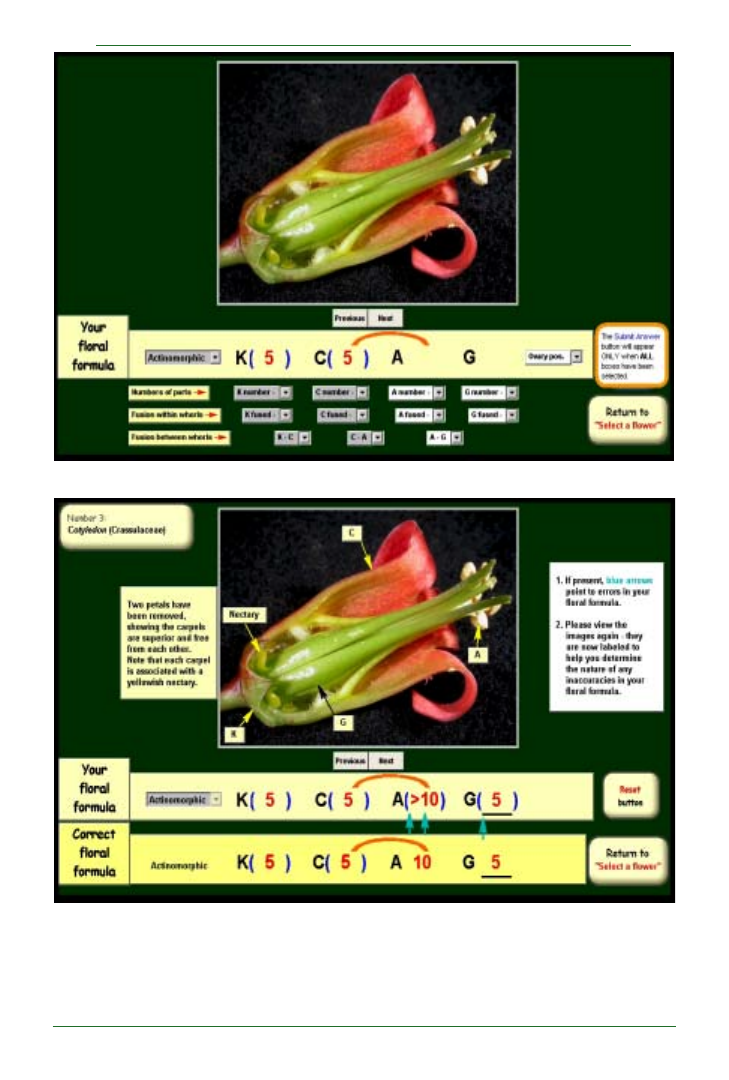
150
Plant Science Bulletin 55(4) 2009
Figure 1 above; Figure 2 below.
Plant Talking Points
(botany.org/PlantTalkingPoints)
This classroom tool on the BSA web page was
recently featured in the Science Teachers GRAB
BAG section of the National Science Teachers
Association NSTA Reports Newsletter. If you’re not
familiar with it, take a look - -
then consider writing
up and submitting one of your favorite botanical
Talking Points to add to the BSA collection!
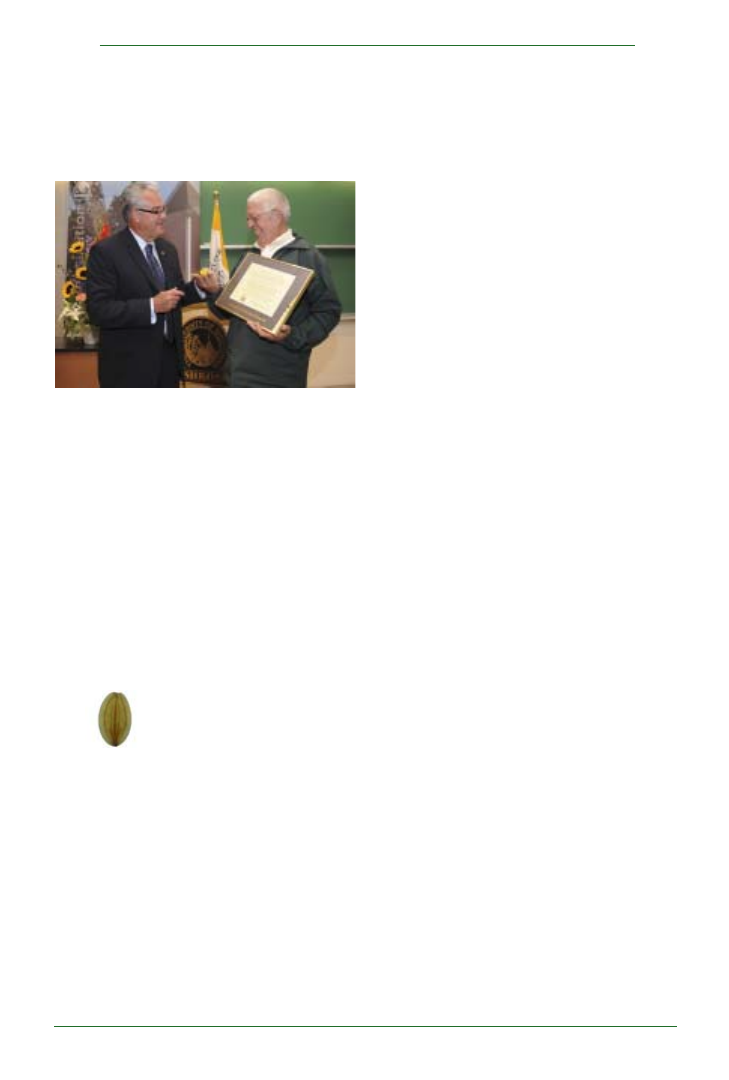
151
Plant Science Bulletin 55(4) 2009
Personalia
New University of Wisconsin –
Oshkosh Herbarium named after
Neil A. Harriman
University of Wisconsin Oshkosh Chancellor
Richard H. Wells presents yellow-button mums to
Professor Emeritus Neil Harriman at a dedication
ceremony for the University’s herbarium on Sept. 9.
Dr. Harriman founded the 3,700-square-foot facility
in 1964, and in honor of his service, the herbarium,
located in Halsey Science Center, henceforth will be
called the Neil A. Harriman Herbarium. (University
of Wisconsin Oshkosh photo)
Symposia, Conferences,
Meetings
National Native Seed
Conference
Plant Materials Development, Production, and
Use in Restoration
Snowbird Utah, May 17-21, 2010
The Native Seed Conference invites all seed
professionals, resource managers, scientists,
citizens, and students of North American
conservation.
This national meeting will bring together the latest
research and developments from public agencies
and the private seed industry.
Plant Materials Development
·- Recent and on-going developments
Seed Production
Seed Zones & Genetic Concerns
- The latest science and research findings through
common garden studies and trials
- Policy roundup: what do the agencies want?
- Climate change: how should this shape our
practices?
Seed Use: Lessons Learned
- Hear first-hand accounts of successes and
mistakes
-Shrublands
-Highways
-Prairies
-Forests
-Deserts
Workshop: Government Procurement Procedures
- Learn how the U.S. government buys seed, how
specifications are made
For updates and information:
www.nativeseed.info
Contact: Rob Fiegener, Institute for Applied Ecology
rob@appliedeco.org
(541) 753-3099 x 201
Announcements
GO-BOTANY!
Framingham, MA - What if you could walk into the
woods, see an interesting plant, pull out your cell
phone, connect to the internet, identify the species,
and access a wealth of information about it? The
National Science Foundation (NSF) felt the concept
was very interesting and has just awarded a four-
year grant totaling $2.49 million to New England
Wild Flower Society for Go-Botany: Integrated Tools
to Advance Botanical Learning.
Go-Botany is a multi-faceted project, including the
creation of an online state of the art plant identification
key for all New England flora. It will build upon the
upcoming New England Wild Flower Society
publication, New England Flora, the first
comprehensive botanical reference of the region’s
plant taxa to be published in the last 25 years.
Who are the audiences for Go-Botany?
The targeted audiences span a continuum from
beginners without previous knowledge to students
with considerable previous exposure to local plants.

152
Plant Science Bulletin 55(4) 2009
The educational products associated with Go-
Botany will be distributed nationally to educational
organizations and will serve as a model for training
in botany.
What are the goals of the project?
*Stimulate interest among teachers regarding native
and naturalized plants of the New England Region;
*Connect students to plant resources as well as
grassroots plant conservation;
*Provide basic skills to beginning botany students;
*Improve informal botany education;
*Provide schools the ability to customize teaching
resources for botany;
*Provide the framework for institutions across the
U.S. to create comprehensive and user-friendly
field-accessible guides to plants.
One direct impact of Go-Botany will be to increase
the level of public interest in botany and plant
identification among youth and adults in our region.
This impact will be measured by:
*Attraction and engagement levels by visitors to the
Go-Botany website;
*Numbers and types of museum and website
visitors who, post-visit, are stimulated to further
explore botanical resources;
*The number and sophistication of website
interactions by individuals who use the Online New
England Flora;
*The number of customized My Plants personal
web pages that are built by users; and
*Increases in involvement of beginners and
amateurs with hands-on, field-based citizen
science.
A second impact will be increased abilities of
informal science educators in New England and
beyond to use plants in teaching activities, as
measured by:
*Interest and attendance at Go-Botany’s botanically-
focused professional development workshops;
*Frequency of educators’ use of the Go-Botany
website;
*Sophistication of botanical content in teaching
activities and student projects;
*Successful use of mobile web-connectivity by ISE
educators and their students to obtain botanical
information while in the field; and
*Successful creation and use of customized field
guides by a variety of nature centers and informal
science programs.
The website will employ three separate types of
keys, so that users will be able to access information
compiled from multiple sources to identify a plant to
the taxon level (usually species level) using the key
best suited to their ability. Once the user works
through a key, they will arrive at a “Taxon Page,”
which will contain color photographs, maps, links
to other sources, and a wide range of additional
information about the plant. The three distinct keys
will be built in the style of an Application Program
Interface (API) so that other institutions can plug the
tool into their systems for plant identification. The
importance of building an easy-to-use, well-
designed user interface (UI) cannot be
overemphasized. A UI that provides users with a
rich set of tools such as easily accessible
illustrations, images, and definitions of botanical
terms will facilitate self-directed and group
exploration, discovery and integration of botanical
knowledge in an informal science/education setting.
The UI will also display Taxon Page information in
an easily-browsed format, with expandable topic
tabs, enlargeable photos, external links to other
resources, and internal links to closely related
species. The UI will facilitate a user’s own research
by supporting queries and allowing results to be
tabulated and saved.
The senior staff team, researching the taxa and
building the computer models, is comprised of
William Brumback (Conservation Director at New
England Wild Flower Society), Dr. Elizabeth
Farnsworth (Author, Ecologist, and Educator, MA),
Arthur Haines (New England Wild Flower Society
Research Botanist), and Sidharth Koul (New
England Wild Flower Society Programmer Analyst).
Key partners for research, development, and testing
include the Yale Peabody Museum of Natural History,
New Haven, CT; the Montshire Museum of Science,
Norwich, VT; and the Chewonki Foundation,
Wiscasset, ME.
“We are extremely pleased with this $2.49 million
grant from the National Science Foundation,” stated
Debbi Edelstein, New England Wild Flower Society
Executive Director. “Building an interactive field
guide designed to teach botany opens the world of
scientific inquiry to a generation that favors the
richness and immediacy of online learning. The
online flora will serve to increase the number of
citizen scientists and to enhance their knowledge
by making comprehensive visual and scientific
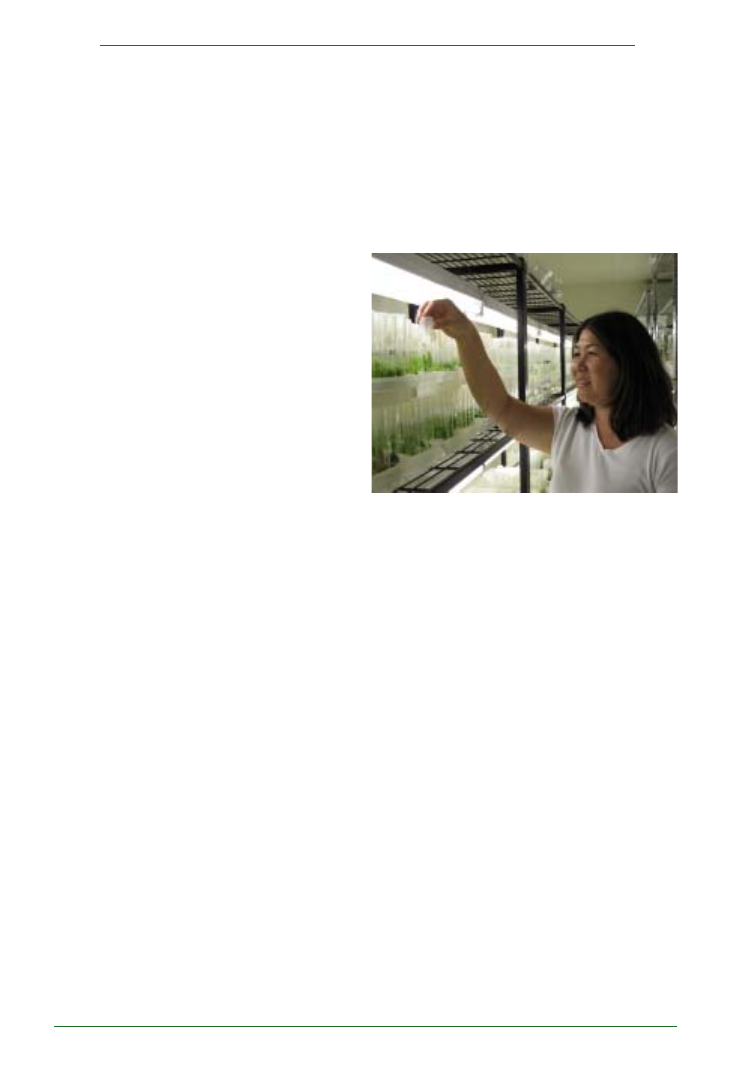
153
Plant Science Bulletin 55(4) 2009
information about New England taxa readily
available. It will also begin the work within the
botany community to create a national online flora,
usable throughout America on portable handheld
devices. It will free important scientific knowledge
from the constraints of heavy books and enable
youths and adults to move into the field and discover
the world of botany.”
“With the online Go-Botany, New England Wild
Flower Society moves the exciting world of botany
into the 21st century and makes botanical knowledge
accessible, which is key to the survival of plants in
this age of global warming. At a time when fewer
people are relating to the natural world, this tool will
enable New Englanders to better understand and
appreciate the green world around them. When you
begin to learn the plants you see every day, your
interest in conservation naturally follows,” stated
William Brumback, Go-Botany Project Director and
New England Wild Flower Society Conservation
Director.
“New England Wild Flower Society is proud that the
National Science Foundation has recognized our
leadership in science education with the largest
grant the Society has ever received,” stated Board
of Trustees Chair Frances H. Clark. “This four-year
grant will enable us to develop and test teaching
techniques using innovative technology with plant,
education, and citizen science communities. Our
exciting and dynamic Go-Botany will increase the
public’s knowledge of plants and their habitats and
grow a community of people who care for and
conserve our vital native flora for future generations.”
UH Mânoa’s Lyon Arboretum
receives nearly $250,000 for
Hawaiian Rare Plant Program
The University of Hawai‘i at Mânoa’s Lyon Arboretum
has been awarded a $248,952 National Leadership
Grant from the Institute of Museum and Library
Services in Washington, D.C., for research on
rescue, recovery and storage of Hawai‘i’s most
critically endangered native plants.
The total project budget, with Lyon Arboretum’s
contribution and matching funds, is $422,927.
“To have such a grant awarded to the Lyon Arboretum
is a true testament to the value of the statewide and
national significance of the work our staff conducts
on endangered plants,” says Director Christopher
Dunn.
Proposed activities for the three-year project will
address issues that have the greatest impact on
plants in in vitro culture and seed storage, and the
management of ex-situ (off-site) collections. The
probability of successfully establishing in vitro
cultures is directly related to the collection process
and handling of field collected plant material.
Staff members engaged in the grant include Dunn,
Nellie Sugii, Alvin Yoshinaga, Cindy Nose, Kalani
Matsumuru and Tim Kroessig.
Nellie Sugii observing the health of a cloned tissue
culture specimen of the endangered species Cyanea
dunbariae.
Plant Ontology Consortium (POC)
The main objective of the Plant Ontology Consortium
(POC) is to develop, curate and share controlled
vocabularies (ontologies) that describe plant
structures and growth and developmental stages,
providing a semantic framework for meaningful
cross-species queries across databases. The
Plant Ontology (PO) has been developed and
maintained with the primary goal to facilitate and
accommodate functional annotation efforts in plant
databases and by the plant research community at
large. As a part of the POC project, participating
databases such as TAIR, NASC, Gramene and
MaizeGDB have been using PO to describe
expression patterns of genes and phenotypes of
mutants and natural variants. The Plant Ontology
Consortium (POC) is funded by the National Science
Foundation.
contact:
http:www.plantontology.org

154
Plant Science Bulletin 55(4) 2009
Kew’s Millennium Seed Bank
Partnership Collects 10% of
World’s Wild Plant Species
BBG and NYC Parks Participate
The New York City Department of Parks & Recreation
and Brooklyn Botanic Garden announced that they
have contributed to the seed banking of ten percent
of the world’s wild plant species through participation
in the worldwide Millennium Seed Bank project
(MSB), based at the United Kingdom’s Royal Botanic
Garden, Kew (RBG). MSB officials announced the
ten percent achievement—a major milestone for
global biodiversity conservation efforts- at Kew’s
Millennium Seed Bank facility in Wakehurst Place,
England.
“Through our historic partnership with Brooklyn
Botanic Garden and Royal Botanic Gardens, Kew,
we have identified and collected the seeds of 75
important and declining local plant species from
the greater New York City area for safe storage and
as a hedge against their possible loss from nature,”
said New York City Parks commissioner Adrian
Benepe.
Brooklyn Botanic Garden president Scot Medbury
said, “Brooklyn Botanic Garden is proud to contribute
its expertise in the native flora of the New York City
metropolitan area, in partnership with the New York
City Department of Parks & Recreation and Royal
Botanic Garden, Kew, to this extraordinary effort.
The progress made by the Millennium Seed Bank
and its worldwide partners speaks to the great
global movement to ensure the future of biodiversity
in our rapidly urbanizing world. BBG will continue to
comprehensively study the vegetation of New York
City and its environs, deepening the understanding
of the city’s plant life and by extension providing a
blueprint for conservation efforts.”
In 2006, the New York City Department of Parks &
Recreation—through its Greenbelt Native Plant
Center (GNPC) on Staten Island—and Brooklyn
Botanic Garden (BBG) were invited by RBG to join
as local partners in its global effort to bank the
seeds of the world’s flora. The GNPC/BBG effort is
distinguished by being the only urban partner of the
worldwide Millennium Seed Bank partnership.
GNPC and BBG agreed to make conservation-
quality seed collections of 75 locally important and
declining species from the greater NYC area. These
species have been collected from wild populations
within the five boroughs and from neighboring
counties, utilizing internationally accepted
standards for capturing maximum genetic diversity.
BBG scientists and GNPC staff selected local
species from regionally rare plant associations
and from plant communities whose ranges are
contracting, largely due to urban and suburban
development and the encroachment of nonnative
invasive species. Selected plant communities
include Oak–Tulip Tree Forest, Red Cedar Rocky
Summit, Maritime Heathland, and Dwarf Pine Plains.
Populations of the selected species were then
located by using current and historical plant location
data from BBG’s New York Metropolitan Flora Project
and by field scouting.
According to Dr. Paul Smith, head of Kew’s MSB
partnership, “The Millennium Seed Bank is not a
doomsday vault where seeds are stored under lock
and key—our mission is to use these seeds to
support conservation and improve people’s lives.
Most of the collections are available for research,
and over a third have a known use to people. This
is very much what the next phase of the Millennium
Seed Bank partnership is all about.”
MSB seeds will be made available to organizations
involved in researching and delivering the
sustainable functions of plants (for example,
drought-resistant crop and forage species,
medicinal speciejesss, and energy-rich species)
and in the restoration of damaged vegetation.
GNPC’s and BBG’s involvement in the Millennium
Seed Bank has yielded several benefits that will
also have a lasting positive impact on local and
regional efforts to conserve native flora. The seed-
banking facilities at the GNPC were renovated with
funds provided by RBG/MSBP to meet international
standards, allowing Parks to expand and enhance
its ongoing efforts of the past decade to preserve
local biodiversity by seed banking and propagating
rare and declining plants in New York City. In addition
to the MSB collections, the GNPC seed bank now
contains more than 1,400 accessions from over
400 plant species from the five boroughs and the
region. In addition, the new seed-storage facility
has enabled GNPC to assist other regional efforts
to collect and bank local seed. The GNPC is now in
the process of formulating plans to organize itself
as the Mid-Atlantic Regional Seed Bank—a seed
repository for restoration and management projects
throughout the region.
The ten percent target was set in 2000 when the
Millennium Seed Bank partnership was formed,
and though this accomplishment is being celebrated
today, a new target looms—collecting and banking
a quarter of the world’s plants by 2020. For more
information about the Millennium Seed Bank and
today’s announcement, visit
www.kew.org/press
.
About BBG’s New York Metropolitan Flora Project
Launched in 1990, the New York Metropolitan Flora
project (NYMF) is a multiyear effort to document the

155
Plant Science Bulletin 55(4) 2009
flora in all counties within a 50-mile radius of New
York City, including all of Long Island, southeastern
New York State, northern New Jersey, and Fairfield
County, Connecticut. NYMF serves as a vital
reference for those involved in environmental efforts
such as preserving rare plants, planning parks and
greenways, repairing degraded habitats, and
designing home gardens in which native plant
communities are preserved or restored.
Chicago Botanic Garden collects seeds
from endangered tallgrass prairie region
Kew’s Millennium Seed Bank Partnership (MSBP)
today announced it has reached it’s goal of collecting,
banking and conserving 10% of the world wild plant
species. The Chicago Botanic Garden collected
and contributed 10,000 seeds from 1,500 species
found in the tallgrass prairie region-which covers
the Midwest and Great Plains. The Dixon National
Tallgrass Prairie Seed Bank, is located at the Plant
Science Conservation Center at the Garden. Due to
habitat fragmentation, the tallgrass prairie has been
reduced to less than 0.01% of its former range,
making it one of the world’s most threatened
habitats—and scientists at the Garden predict that
climate change may further endanger this habitat.
The goal of this project is global in scope. The Dixon
National Tallgrass Prairie Seed Bank, in association
with the national Seeds of Success (SOS) program,
is part of an international seed conservation initiative
collectively known as the Millennium Seed Bank
Partnership (MSBP), originally developed by the
Royal Botanic Gardens, Kew, in England. In 2000
the global program set a goal to bank 10% of the
world’s flora by 2010 for long-term storage and
conservation.
Seed banking—conserving and storing species
away from their original habitats—enables plants
to escape threats imposed by destructive habitat
changes, including urbanization, climate change,
invasive species, over harvest and pollution. This
method guards against species’ disappearance in
the wild and is an important way botanic gardens
are helping to conserve plant diversity.
Between 2003 and the end of 2010, the Chicago
Botanic Garden committed to collect seeds from
1,500 native species across the Midwest, with an
emphasis on tallgrass prairies species.
“I think of the seed bank as a refuge in a bottle. Once,
plant species might have found refuge from such
changes on a distant mountaintop—now they will
find it in a freezer. I believe this is the most important
long-term conservation project currently underway
at the Chicago Botanic Garden,” said Dr. Pati Vitt,
Curator of the Dixon National Tallgrass Prairie
Seed Bank. “Climate change has occurred naturally
over the millennia, and most organisms proved
capable of either adapting or migrating in the face
of such environmental change. The changes that
we are seeing now, however, are occurring too
rapidly for many species to adapt, and given the
patchwork of natural areas interspersed with human
development, it may be very difficult for many species
to migrate.”
Every seed is a living potential plant, and once dried
and frozen, they can remain viable for 200 years or
more. For every 1% reduction in seed moisture
content, the lifespan of a seed is doubled, making
seed collection an efficient and cost effective way to
conserve the diversity of plant species for
generations to come.
Additionally, the Chicago Botanic Garden is planning
on expanding the original MSBP goal, which banks
one population per species, to become a repository
for multiple populations of each of our target
collection species. Initially focused on collecting
species of high restoration importance from each
of the eco-regions that comprise the tallgrass prairie
system, the seed bank will then be a valuable
restoration collection for conservation purposes
and as a resource for a wide community of scientists
and land managers. The Chicago Botanic Garden
hopes to collect over 100 million seeds from 2,500
native species in the next ten years.
With the recent opening of the Daniel F. and Ada L.
Rice Plant Conservation Science Center, the
Garden’s staff of over 200 full-time scientists,
research assistants and students provide
leadership on solutions for plant conservation
problems caused by climate change, habitat loss
and fragmentation, invasive species and pollution.
“The Reproductive Biology Lab, Geographic
Information Systems facility, and Seed Bank will all
be right next to each other,” says Dr. Vitt. “So all
aspects of seed production, collection, storage and
curation will be integrated and expanded.”
The Chicago Botanic Garden’s Dixon National
Tallgrass Prairie Seed Bank collects in 14 states
across the Midwest and the northern Great Plains
including Minnesota, Wisconsin, North Dakota,
Michigan and Iowa. For more information on the
Garden’s Dixon National Tallgrass Prairie Seed
Bank, visit
http://cbgseedbank.org
or call (847) 835-
6861.
“It will be years before we run out of storage capacity
for the seeds,” said Dr. Vitt.
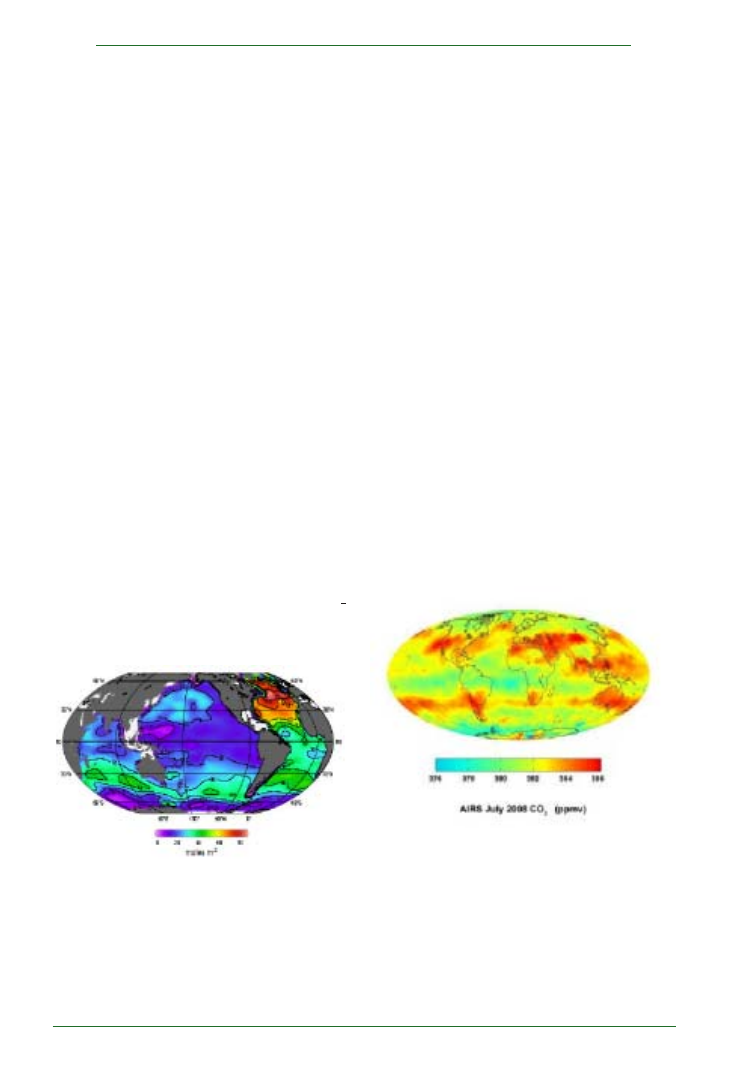
156
Plant Science Bulletin 55(4) 2009
Climate Change Symposium:
Carbon Cycling and Sequestration
in the Sea by Phytoplankton and
Macrophytes.
AnitraThorghaug
1
, John Raven
2
, Erica Young
3
,
Linda Franklin
4
. Botanical Society of America,
Snowbird Utah, July 29, 2009
1. Yale University, School of Forestry and
Environmental Studies, New Haven, Ct.; 2. University
of Dundee, Dundee, Scotland; 3. University of
Wisconsin, Milwaukee; 4 .Smithsonian
Environmental Research Center, Edgewood, MD.
The Utah meeting of the Botanical Society of America
(July 29, 2009) was the site of a dialogue concerning
carbon dioxide cycling by marine plants. This
included potential problems and solutions for
carbon sequestration in marine biota. Our
conclusions included how marine plants will be
and are being affected by increasing levels of carbon
dioxide dissolved in the oceans and seas. The
oceans presently contain differing concentrations
of both plants and carbon as well as a wide variety
of plant phyla. Various genera respond very
differently to carbon dioxide in seawater (based on
experimental values of plant responses). Within the
plants’ limits, most responses are proportional to
the varying concentration of carbon. The central to
far North Atlantic Ocean currently has the highest
concentration of oceanic carbon dioxide (Fig. 1).
still important, areas of carbon dioxide concentration
include the southern Atlantic, the southern Indian,
and the southern Pacific oceans (both with east-
west bands). A site in the northwest Arabian Sea
appear to contain the second highest concentrations
of inorganic carbon (Figure 1). These areas of
accumulation are the most likely to show plant
responses to anthropogenically increased CO
2
.
Although the NOAA (2005) and other results indicate
that the largest portion of carbon dioxide is in the
upper 10% of the oceans, the atmospheric
distribution of carbon dioxide differs considerably in
location from the oceanic concentration. The
discussions of oceanic processes of absorbing
and distributing carbon dioxide included both the
solubility pump, with the thermocline circulation,
and the biological pump, comprised of plant
distribution and plant physiological processes.
Raven discussed the differential CO
2
solubility in
seawater as a function of temperature and salinity
and equilibrates with the other components of the
inorganic system ((H
2
CO
3
, HCO
3
-
and CO
3
2-
, as well
as H
+
/OH
-
) and how the components of the inorganic
chemical equilibrium enters cells and are used (as
CO
2
) in photosynthesis. Thorhaug discussed the
profiles of carbon dioxide in the atmosphere and
oceans (Figures 1 & 2) as influenced by the
thermohaline circulation found though out the deeper
ocean (Figure 4) with its role in coincidence with the
release of CO
2
to and the uptake of CO
2
from the
atmosphere
(Figure 4)
as well as the transfer of
heat. The thermohaline circulation is related to the
CO
2
patterns found in the South Pacific and South
Indian Ocean as well as the far north Atlantic Ocean.
The biological carbonate pump (near-shore for
mangroves, marshes, seagrasses, and
Figure 2. AIRS 7/08 large scale patterns measured CO2
transported around Earth by ATMOSPHERIC circulation
NASA, showing in red the large scale patterns of
atmospheric CO
2
concentrations indicating large scale
differences among regions especially in the northern and
southern terrestrial areas. The origin of accumulations
over the undeveloped areas in the southern oceans is not
clear at present.
Figure 1 Measured dissolved carbon dioxide in the
world’s oceans. From NOAA 2004 . Notice descrepancies
between the hotspots of oceanic carbon dioxide herein
and atmospheric carbon dioxide from Figure 2.
Reports and Reviews
This is where both accumulations of excess carbon
input from industrial, transport, and mining
processes (Figs. 2,3) as well as from the oceanic
loss of heat and carbon exhalation occur. Lesser,

157
Plant Science Bulletin 55(4) 2009
macroalgae, and near-shore and open ocean for
the phytoplankton) was discussed by Young and by
Thorhaug in their presentations of phytoplankton
and macro-plant responses and their transport
carbon from the surface euphotic zone to the ocean’s
interior and sediment especially in shallow waters
coastal waters and estuaries, but also in, and upper
200 m of the oceans and seas. It was emphasized
that the open ocean regions only support
photosynthetic production in the surface -200 m
due to light limitations in deeper zones. Thorhaug
pointed out that the Atlantic, Pacific & Indian Oceans
had taken up 118 billion metric tons of CO
2
human
sources 1800-1994, which is said by NOAA to be
one third of oceans’ long-term potential. The ocean
has removed 48 percent of the excess atmospheric
CO
2
over 200 y. One half of this anthropogenic CO
2
can be found in the upper 10 percent of the ocean
where the plants are able to live. Discussions by
Thorhaug included where carbon enters the oceans
and is currently stored (including sediment, coral,
phytoplankton, macroalgae, shoreline higher plants
shoots and roots), and that a great deal entered in
geological times when continents (especially India)
scudded across ocean floor releasing carbonate
sediments).
The Problem of Acidification of the Ocean - John
Raven
Continuing ocean acidification occurs as a result of
anthropogenic CO
2
release to the atmosphere with
about a quarter dissolving in the ocean, increasing
the CO
2
and H
2
CO
3
concentrations, increasing the
HCO
3
-
concentration relatively less (but more in
absolute terms), and decreasing the CO
3
2-
concentration. Growth of many non-calcified marine
photosynthetic organisms is saturated by the present
concentration of inorganic carbon species in the
surface ocean. Other non-calcified photosynthetic
organisms such as some phytoplankton species
and a number of macroalgae and seagrasses, with
a less effective or no CO
2
concentrating mechanism,
show increased growth when more CO
2
is added
to present-day seawater.
For calcified photosynthetic organisms (e.g.
coccolithophores, and symbiotic foraminifera and
corals) there is the additional complication that in
many cases calcification, and thus growth, is
decreased when carbon dioxide is supplied at
greater than the present levels. With the additional
complication of warming of the surface ocean with
less deep mixing, and so a smaller input of nutrients
regenerated in the deep ocean, it is difficult to
predict the outcome of global environmental change
for marine primary productivity, though species
composition will change and there may be a
decrease in the oceanic ecosystem services
provided by photosynthetic organisms. Fertilization
of iron- and of nitrogen-limited areas of the ocean
with the respective limiting nutrient has been
proposed and, for iron, tested as a means of
bioremediation of both ocean acidification and
increased atmospheric CO
2
. However, major
remediation is unlikely to occur, and there could be
undesirable side effects.
John Raven emphasized in the calcium carbonate
cycling in the sea that increasing carbon dioxide will
create two effects in plants: changes in
characteristics of plant physiological processes
such as photosynthesis and enzyme functioning
and significant oceanic fractionation of location of
CO
2
. Significant variation in sea-surface CO
2
concentration is already and will continue to be a
potential result with CO
2
more soluble in cold water.
CO
2
taken up near poles, released in equatorial
upwellings as deep, CO
2
-rich water comes to the
surface and warms due to the oceanic Solubility
Pump. Simultaneously the Biological Pump
potentially will create CO
2
assimilated by
organisms, with some biomass sequestered into
sediment ( particularly by Green, Red and brown
algae and by the sequestering higher marine
plants), while in most biologically processes carbon
is mineralised back to CO
2
, or dissolved organics
of which much will come to the surface in upwellings.
Additionally, there are temporal variations in
inorganic carbon and pH in surface ocean seen as
significant variation in sea-surface CO
2
concentration as a result of Diel (biological) and
seasonal (biology, temperature) variations. Report
of decadal variations, based on ä11B in coral
aragonite as a proxy for the pH at which the deposition
occurred (although there are some problems with
the methodology). Still disputed are natural
variations with over-ride effects of anthropogenic
CO
2
in poorly flushed coastal waters.
Figure 3 Air-sea fluxes CO
2
/y. “Red” indicates release from
ocean waters to atmosphere. The “blue” and “pink”
indicate uptake whereas the “red, orange and yellow”
indicate exhalation by the oceans. Note similarities with
thermohaline current giving off heat in Figure 4 .(Takahashi
et al. 1999 )

158
Plant Science Bulletin 55(4) 2009
Continuing effects of anthropogenic CO
2
emissions
into the atmosphere include the following oceanic
effects: 1.) increasing anthropogenic CO
2
emissions will continue to increase surface [CO
2
],
[HCO
3
-] and [total inorganic C], and decrease pH
and [CO
3
2-] ; 2.) Increasing effects of the added CO
2
deeper in the ocean; 3.) Significant biological of
shoaling of the saturation horizons of the main form
of biologically precipitated CaCO
3
until the surface
ocean becomes under saturated (by 2050 at high
latitudes) ; 4.) Increasing anthropogenic CO
2
emissions will continue to increase surface [CO
2
],
[HCO
3
-] and [total inorganic C], and decrease pH
and [CO
3
2-]; 5.)In the long term (1 -10 kyr) the
increasingly CO
2
-enriched waters will dissolve
carbonates, increase dissolved alkalinity at depth
and ultimately return higher-alkalinity water to the
surface; 6.) Surface pH and [CO
3
2-] increase:
surface waters once more supersaturated with
calcite, then aragonite. Occurring within the
physiology of plants will be the following: 1.) Many
marine photosynthetic organisms will become
saturated with inorganic carbon for cell doubling
time, despite Rubisco kinetics; 2.) Presence of
inorganic carbon concentrating mechanisms,
based on active transport across membranes; 3.)
Same outcome as from C
4
plant’s photosynthesis
on land – but evidence supporting C
4
photosynthesis
in phytoplankton needs careful analysis (work on
Thalassiosira pseudonana and T. weissflogii).The
main emphasis on ocean acidification in the media
has been on the effects on organisms with CaCO
3
skeletons, although most marine CaCO
3
precipitation involves photosynthetic organisms.
Note that planktonic coccolithophores have calcite,
as do unicellular primary producers. Planktonic
and benthic: foraminifera have calcite as do other
unicellular grazers and, when symbiotic with algae
as in corals, primary producers have calcite (only
photosynthetic in warmer waters).
Phytoplankton CO
2
Uptake and Nutrient- Limited
Productivity - Erica Young
Phytoplankton in the surface oceans represent
relatively small biomass compared with terrestrial
ecosystems but grow over a much larger area and
have much higher biomass turnover than terrestrial
plants and contribute up to 40% of global
photosynthesis (Falkowski, 1994) and thus play a
critical role in the global carbon cycle. High
phytoplankton biomass is observed in the
nearshore, in coastal upwelling zones, in freshwater
lakes and in many open ocean areas but
phytoplankton are limited by nitrogen, phosphorus
or iron limitation in large areas of the ocean.
Algae and cyanobacteria have evolved inorganic
carbon concentrating mechanisms (CCMs) to
compensate for CO
2
limitation in water (reviewed by
Giordano et al. 2005). CCMs improve C fixation
efficiency and involve synthesis of transmembrane
transporter proteins, enzymes and expenditure of
ATP for active inorganic C uptake.
Laboratory analysis suggests that in select green
microalgae, diatoms, and a coccolithophorid, active
inorganic C uptake and function of the CCM can
either be upregulated or down regulated in response
to N, P or Fe limitation, depending on the taxa
(Riebesell et al. 2000, Young and Beardall 2005,
Beardall et al. 2005, Schulz et al. 2007). However,
not only are responses likely to be taxon specific but
studies have covered very few taxa, so extrapolation
to field conditions may be very difficult.
In situ open ocean iron fertilization experiments
provide opportunities to examine the interactions
between nutrient limitation and C sequestration by
the open ocean phytoplankton. Open ocean regions
have been shown to be iron limited (Martin and
Fitzwater 1988, De Baar et al. 2005) and iron
enrichment stimulates phytoplankton growth and
CO
2
draw-down. More recent experiments have
focused on addressing key questions including
which taxa respond most readily to Fe enrichment
and whether the biomass results in C transfer to the
deep oceans. Cassar et al. (2004) showed no
apparent effect of iron enrichment on inorganic C
acquisition processes (as
13
C/
12
C fractionation),
More data on the physiological responses of
inorganic C acquisition need to be incorporated into
future in situ open ocean fertilization experiments.
The scientific consensus is that iron fertilization is
likely to have very doubtful ecological benefits.
Despite this consensus (see also Glibert et al.
2007), ocean fertilization to stimulate C
Figure 4. The deep and surface circulation of the oceans
with release of heat and gases thermohaline circulation.
Note similarities between point of heat release to air and
degassing in Figure 3

159
Plant Science Bulletin 55(4) 2009
sequestration by phytoplankton has attracted the
carbon credits trading industry.
Speculation on possible implications of rising CO
2
and global climate change for inorganic C
acquisition and nutrient limitation includes the
expectation in with lower oceanic pH and higher
dissolved CO
2
, acquisition of inorganic C may be
easier for phytoplankton (Hein & Sand-Jensen
1997). However, CO
2
acquisition efficiency under
present-day CO
2
levels and therefore responses to
elevated CO
2
are likely to be very variable (e.g. Hein
and Sand-Jensen 1997, Tortell and Morel 2002).
Anthropogenic nutrient inputs to nearshore regions
can stimulate phytoplankton production (e.g.
Lohrenz et al. 2008), but may result in negative
ecological effects. However, global climate change,
and current phenonema such as the North Atlantic
Oscillation and the El Niño Southern Oscillation
are likely to increase drought and desertification of
continental areas including West Africa and
Australia (Jickells et al. 1998; McTainsh and Strong
2007). This will result in elevated aeolian dust
deposition into open ocean regions, bringing iron
and other nutrients, which have been shown to
stimulate phytoplankton production (Sarthou et al.
2003; Tovar-Sanchez et al. 2006; Shaw et al. 2008).
Global climate change will likely affect inorganic C
acquisition processes in phytoplankton through
both changes in CO
2
availability and oceanic pH,
and in nutrient supply to oceans. We currently need
more field-based physiological studies of how
phytoplankton take up and sequester CO
2
under
nutrient replete and limited conditions
The Participation of Ultraviology Light in the Marine
Plant CO
2
problems Linda Franklin
Simultaneously, with the problem of the carbon
dioxide build up in the oceans is the ozone and ultra
violet increase in the global atmospheric shield,
which is reflected in responses of marine plants.
What does O
3
depletion mean for algae? Biological
impact of O
3
includes damage, repair, and
acclimation. Relevant to the environmental
exposure of O
3
is appropriate dose (time and
spectrum), and the use of biological weighting
functions (BWF) to model the spectral response to
natural scenarios. There are specific molecular
targets of UV-B light, including nucleic acids,
especially pyrimidines, in which alterations can be
photo destructive forming pyrimidine dimers. The
effects block DNA and RNA polymerases until
repairs are made; perhaps long-term mutations
are also an effect. There are also physiological
targets of UV such as proteins, lipids (via a
photosensitiser), porphyrins, and quinones. These
appear to be altered by photo-oxidation, and cross-
linking of amino acids. These effects include loss
of protein content, function, or membrane integrity
until repairs are made or acclimation occurs.
Do long-term mutations occur over time? We do not
know. Photosynthesis as well as carbon allocation
was effected, as nutrient uptake changed cell
division and nitrogen fixation. Respiration, showed
a great variability among species as did other
measurements. Lower net primary productivity was
a particular feature as was inhibition of light reactions
(PSII) making lower photosynthetic efficiency.
Basically, inhibition of carbon fixation (RuBisCO)
occurred to lower the maximum rate. There were
effects on carbon concentrating mechanisms (CCM)
– TBD and in extreme cases a loss of chlorophyll,
occasionally there was acclimation.Up-regulated
transcription of photosynthetic genes occurred. Also
found was enhanced scavenging of reactive O
2
species. As well as synthesis of UV-absorbing
compounds. Mycosporine-like amino acids (MAAs)
and polyphenolics (phlorotannins) resulted. There
was a change in priority for synthesis of
macromolecules
The Sequestration of Carbon by Restoration of
Marine Macro- plants - Anitra Thorhaug
The reasoning of Hansen et al. 2008 to the problem
of increasing global anthropogenic atmospheric
carbon dioxide is that an important solution is to
restore forests which will create a safety measure
by decreasing atmospheric CO
2
by 60 ppm. Their
assumptions are that deforestation on the planet
will end in 2015 and that reforestation (and growth
of these restored trees) will peak at 2030 at which
time there will be yearly additions from the restored
forests of 1.6GTC/y (he does not take forest fires or
insect decimation into account). Thorhaug
challenged this statement as the biological solution
because when carbon sequestration solutions are
being sought, the restoration of long-lived marine
macro-plants need to be examined and these have
not been calculated by Hansen et al.2008 as a
portion of the sequestration solution. This
calculation has nothing to do with the phytoplankton
suggestions for sequestration and enhancement
of a series of investigators. A series of experts have
stated the ocean has removed 48 percent of the
excess atmospheric CO
2
over 200 y of which a large
share is found in the upper 10 percent of the ocean
where the plants live. Marine macroplant restoration
remains an important solution to the total global
restoration and sequestration problem since: 1.) A
great extent of the marine macroplants have been
lost over the past 200 years therefore greatly
diminishing the ocean’s capacity to cycle and
sequester carbon; 2.) The production (uptake of
CO
2
) and growth of marine plants is very high
compared to terrestrial species (gross primary

160
Plant Science Bulletin 55(4) 2009
productivity marine coastal species is 2194 gC m
-
2
y
-1
, net productivity 1151gC m
-2
y
-1
,and net global
photosynthesis 3299 Tg y
-1
); 3.) Much of the excess
CO
2
is found in the upper waters of the oceans and
accessible for marine plants; and 4.) There are few
impediments to partial marine plant restoration
around the world in terms of competition for space,
or types of negative factors decimating forest
restoration (fire and pests); 5.) New technologies
for restoration of most of the marine macroplant
species have resulted in persistence of new
restored areas around the globe. (Substantial time
was devoted to showing these persistent
restorations). To compare the forest restoration
solution to the marine macro-plants, Thorhaug
calculated the present extent of four various major
groups of macro-marine plants and a very
conservative estimate of extent of potential restorable
of the four groups: Marshes, mangroves,
seagrasses and macro-algae along with
extrapolating their present depositional carbon (
Duarte and Ceprian (1995) , Raven (1991), Hay
(1988)and includes in the table the potential
depositional carbon from the restored plants. She
also calculated in a highly conservative way the
potential of restoring only 20% of the extent previously
lost in the last half century. (This was by averaging
lost habitat from experts’ estimates.) The results
were surprising. The extent covered by marine
macro-plants is spatially one fourth of the present
extent of forest cover in the world (similar in
magnitude to the forest to be restored). The marine
plants, particularly the macro-algae, seagrasses
and marshes are some of the highest primary
producers in the world. When their potential spatial
extent for restoration is multiplied by their productivity
they become an important and productive force to
sequester carbon dioxide, from both ocean and
atmospheric sources. The mangroves have long
sequestration times as do the seagrasses and
some of the macroalgae, all found in paleo records.
The marshes no doubt also have sequestration
times measured in at least decades, the other
macroalgae differs from years to decades. There
are many reasons for restoring these marine
macroplants’ services other than carbon
sequestration: 1.) These are nursery habitat for the
world’s diminishing near shore fisheries; 2.) These
are sediment stabilizers cutting down turbidity and
erosion; 3.) These are a food and habitat source
providing for a rich biodiversity of food webs from
boreal to tropical ecosystems, which food webs
reassemble after restoration first seen for
seagrasses by McLaughlin et al. (1984). This
restoration effort will have several additional
services beyond sequestration, including providing
employment for the young and people in poverty
chiefly in the developing world (a large extent of the
sites needing restoration are located in newly
contents estimated based on Gacia et al. (2002),
Holmer et al. (2004), Kennedy et al. (2004), Duarte
et al. (2005a) , sediment load buried on Milliman
and Syvitski (1992), Hay(1998), and Walsh and
Dieterle (1988) and extent, loss and production
based on Raven(1991) , Duarte et al. (2005), Duarte
and Ceprian (2005), Charby-Robaud and Sourna,
Green & Short (2005), FAO. (2003), Gacia et al.
(2002), Lugo (1988), Mateo et al. (2004), North,
1981, Paling, et al. (2009), Saenger (1983), Saenger
(personal communications 2009), Spalding
(1997),Thorhaug (1976),Thorhaug and Cruz (1989).
AKNOWLEDGEMENTS; Thanks to the BSA
Physiological Section and Ecological Sections for
symposium support.
developing nations). The summary tables are below
(Table 1 and Table 2). Data in these tables is taken
from a series of investigators : Organic carbon
Richard Polwhele, 1798, argued that women who
study plants engage in sexual activity and that
“botanizing girls…do not take heed…, they will soon
exchange the blush of modesty for the bronze of
impudence.” But not all agreed...
With bliss botanic as their bosoms heave,
[they] Still pluck forbidden fruit, with mother Eve,
For puberty in sighing florets pant,
Or point the prostitution of a plant;
Dissect its organ of unhallow’d lust,
And fondly gaze the titillating dust.
In: Richard Polwhele, 1798, The Unsex’d Females.
(London)
Happy for England, were each female mind,
To science more, and less to pomp inclin’d
If parents, by example, prudence taught,
And from their QUEEN (Charlotte, wife of George III) the
flame of virtue caught!
Skill’d in each art that serves to polish life,
Behold in HER a scientifick [sic] wife!
In: The Lady’s Poetical Magazine, or Beauties of British
Poetry 1:1-4. (1781)
In 1773 Sir Joseph Banks named Strelitzia reginae
in honor of Queen Charlotte “as a just tribute of
respect to the botanical zeal and knowledge of the
present Queen of Great Britain.”

161
Plant Science Bulletin 55(4) 2009
therestored forest (forest and atmospheric numbers by Hansen et al (2008)) ppm of CO
2
increase
with potential for marine plants and their carbon by Thorhaug, 2009.
Ecosystem
Area
NowBuried Potential
Potential*
New C
Total Restored
Type
10
12
m
2
# TgC
new area
change
NetRestored Burial
10
12
/m
2
/y
10
12
m
2
CO
2
gCT10
12
TgC10
12
/y
Forests
4.
100
0.13
60 ppm
130
(Hansen et al.2008)
Plankton.
332
0.18
359
unknown
0.02
0.02
Deposition
Marine
1.0
373
1.01
unknown
811.13 61.4
macroplants
Table 1 Potential area for restoration restore in the marine environment which previously supported large
macrophyte and halophyte plant communities.
Type ofMarine Potential Globe T gC Net Living restored
Total new Primary
ecosystem Restored x 10
12
/y
global C
production C
area 10
12
m
2
buried CTg produced 10
12
/y CTg 10
12
/y
marsh
0.14
21.14
221.9
243.04
mangrove
0.5
20.12
33.14
53.26
Seagrass
0.093
7.7
104.
111.7
macroalgae
0.28
12.44
444.36
456.80
Total marine
1.013
61.4
811.13
864.8
macroplants
LITERATURE CITED
Behrenfeld MJ, Westberry TK, Boss ES et al. 2009.
Satellite-detected fluorescence reveals global
physiology of ocean phytoplankton. Biogeosci. 6:
779-794.
Beardall J, Roberts S, Raven JA. 2005. Regulation
of inorganic carbon acquisition by phosphorus
limitation in the green alga Chlorella emersonii.
Canadian Journal of Botany 83: 859-864.
Cassar N, Laws EA, Bidigare RR, Popp BN 2004.
Bicarbonate uptake by Southern Ocean
phytoplankton. Global Biogeochemical Cycles 18:
GB2003.
Charby-Robaud C. and A. Sourna,1990.comparative
estimation of phytoplankton and micro-phytobenthic
production in the ocean. Marine Microbiology. Food
Webs 4:31-57.
Table 2 Potential to restore carbon (C) by various marine plant types compared to potential to
restore forests with the carbon the newly restored plant material might produce from the both

162
Plant Science Bulletin 55(4) 2009
Lugo, 1988. Forested Welanads in fresh water and
salt water environments. Limnology and
Oceanography. 38(2):884-909.
Martin JH and Fitzwater SE. 1988. Iron-deficiency
limits phytoplankton growth in the Northeast Pacific.
Nature 331, 341-343.
Mc Laughlin, P.A., A. Thorhaug, S. Treat, and
R.LeMaitre 1983. A restored seagrass Thalassia
bed and its animal community. Environ.Conserv.
10(3):247 253.
McTainsh G. Strong C. 2007. The role of aeolian
dust in ecosystems Geomorphology 89: 39-54.
Mateo Mateo, M. A., Cebri ´an, J., Dunton, K., and
Mutchler, T. 2005 Carbon flux in seagrass
ecosystems, 672 In Seagrass Biology and Ecology,
edited by Larkum, A. W. D., Orth, R. J., and Duarte,
C. M., Kluwer, 2004.
Milliman, J. D. and Syvitski, J. P.: Geomorphic/
tectonic control of sediment discharge to the ocean:
the importance of small mountainous rivers, J.
Geol., 100, 525–544, 1992.
North, W. and K.C. Wilson 1981.A review of kelp bed
management in Southern California. World
Mariculture 14:345-359.
Paling, E.I, Fonseca, M. M. Van Katwijk,
MM.VanKeulen, Fonseca, 2009 Seagrass
restoration. pp. 687-713 In: Coastal wetlands: an
integrated ecosystem approach. Perillo G, Wolanski
E, Cahoon D, Brinson M (eds). Elsevier, Amsterdam.
Raven, J.1991. Plant, Cell & Environment 14: 779-
794.
Roberts K, Granum E, Leegood RC, Raven JA.
2007. C-3 and C-4 pathways of photosynthetic
carbon assimilation in marine diatoms are under
genetic, not environmental, control. Plant Physiology
145: 230-235.
Roberts.K. 2007 Plant Physiology 145: 230-235
Romero J.,M. Perez, M.A. Mateo, E. Sala. 1994. The
below ground organs of the Mediterranean
Falkowski PG. 1994. he role of phytoplankton
photosynthesis in global biogeochemical cycles.
Photosynthesis Research 39: 235-8.
FAO, 2003.Status and Trends in Mangrove Area
Extent. M L Wilkie and S Fortuna eds. Forest
Resources Assessment Working Paper, 63. FAO,
Rome.Italy.
Field et al. 1998 Science 281: 237-240.
Gacia,E, C M Duarte. 2001. Elucidating sediment
retention by seagrasses: Sediment deposition and
resuspension in a Mediterranean (P.oceanica)
meadow. Estuar. Coast. Shelf Sci. 52:505–514.
Giordano M, Beardall J, Raven JA 2005. CO
2
concentrating mechanisms in algae: Mechanisms,
environmental modulation, and evolution. Annual
Review of Plant Biology 56: 99-131.
Glibert, PM, Azanza R, Burford M et al. 2008. Ocean
urea fertilization for carbon credits poses high
ecological risks. Marine Pollution Bulletin 56: 1049-
1056.
Granum, et al. Journal of Phycology ( in press).
Hansen, J, M. Sato, P. Kharecha, D. Beerling, R.
del Giorgio & Williams 2005. (eds) Respiration in
Aquatic Ecosystems. OUP, Oxford
Duarte CM and J Ceprian. 1995.The fate of marine
autotrophic production: a reassessment. Aquatic
Botany 65:159-174.
Duarte CM, Middelburg J,Caraco N. 2005. Major
role of marine vegetation on the oceanic carbon
cycle. Biogeosciences 2:1–8.
Jickells TD, Dorling S, Deuser WG, Church TM,
Arimoto R, Prospero JM. 1998. Air-borne dust fluxes
to a deep water sediment trap in the Sargasso Sea.
Global Biogeochemical Cycles 12: 311-320.
Lohrenz SE, Redalje DG, Cai WJ, Acker J, Dagg M
2008. A retrospective analysis of nutrients and
phytoplankton productivity in the Mississippi River
plume. Continental Shelf Research 28: 1466-1475.
Berner, V. Masson-Delmotte, M. Pagani, M. Raymo,
D.L. Royer, and J.C. Zachos, Target atmospheric
CO
2
: Where should humanity aim? Open Atmos.
Sci. J., 2, 217-231.
Hay, W. W.1998 Detrital sediment fluxes from
continents to ocean. Chem. Geol., 145, 287–323.
Hein M, Sand-Jensen K. 1997. CO
2
increases
oceanic primary production. Nature 388: 51-52.
De Baar HJW, Boyd PW, Coale KH et al.
2005.Synthesis of iron fertilization experiments: in
From the Iron Age to the Age of Enlightenment. J
Geophys. Res. 110: C09S16.
De Vooys CFN ,1979Primary productivity in aquatic
environments. inThe Global Carbon Cycle (Bolin et
al. eds), pp.259-292, Wiley, Chichester 292.

163
Plant Science Bulletin 55(4) 2009
Growing a Green Planet: The
Future of Botany Teaching
John Cozza, Department of Biology, University of
Miami
Growing up in the 1960s, I experienced two
contrasting visions of the future: one featuring
gleaming glass cities, the other a post-apocalyptic
return to the caves. Recently, a grim new vision of
the future has emerged: one of wild climate changes,
rising seas, and mass extinction. To escape this
last vision, we must recognize and preserve our
interconnections with the Earth and its other
residents, especially the plants that nourish us all.
This will be quite a challenge. Many people in the
so-called developed world suffer from what
Wandersee and Schussler (1999) have so aptly
termed “plant blindness.” Plants are reduced to
decorations (even to plastic imitations), or thought
of as boring—symbolized by that iconic diagram of
a flower we had to memorize in high school. Kids,
when asked where their food comes from, reply “the
store.” Many people never experience natural areas.
Furthermore, in academia, old ways of doing things
may get entrenched, and the community of botanists
is often not as diverse as the communities we
serve. Adding to the challenge is the relentless
destruction of plants and their habitats, especially
in the tropics. We simply don’t have a lot of time.
Fueling the destruction, the corporate community
tells us we need bigger cars, bigger houses, and
more of everything. Meanwhile, our students
graduate with a mountain of debt that severely limits
their career choices.
After presenting what a friend calls the “doom and
gloom” predictions of the climate and extinction
models, I ask my students, “Why am I telling you
this?” The obvious answer, and one we must
stress in our teaching, is that we probably can
prevent catastrophe, if we act decisively now—and
that doing so is, despite rampant misinformation to
the contrary, economically feasible (Zurich 2009,
Krugman 2009). Without this “closer,” we may
unintentionally be advising our students to feel
helpless and deny our message.
Teaching is crucial to growing an alternative future
vision of a green planet. With our inspiration and
guidance, our students will take a botanical journey
in which they become aware of and connect to
plants, feel included as they explore botany and
horticulture, and develop a sense of ownership of
the plants in their lives. As they come to love plants,
they will be motivated help conserve them and their
habitats by sharing the Earth in a sustainable way.
seagrass Posidonia oceanica as a biogeochemical
sink. Aquat. Bot. 47:13-19.
Saenger, P., Hegerl E.J. and J.D.S., Davie. 1983.
Global status of mangrove ecosystems.
Commission on Ecology Papers No.3. IUCN. Gland,
Switzerland. 88 pp.
Seneca, ED SW Broome, WW Woodhouse Jr. 1976.
Establishing Spartina alterniflora Marsh in NC .
Environmental Conservation 3:185-188.
Sarthou G. Baker AR, Blain S, Achterberg EP, Boye
M, Bowie AR, Croot P, Laan P, de Baar HJW, Jickells
TD, Worsfold PJ. 2003. Atmospheric iron deposition
and sea-surface dissolved iron concentrations in
the eastern Atlantic Ocean. Deep Sea Res I, 50:
1339-52.
Shaw EC, Gabric AJ, McTainsh GH. 2008. Impacts
of aeolian dust deposition on phytoplankton
dynamics in Queensland coastal waters. Marine
and Freshwater Research 59: 951-962.
Smith 1981. Science 211: 838-840.
Spalding, M.D., Blasco, F. & Field, C.D., eds. 1997
World Mangrove Atlas. The International Society for
Mangrove Ecosystems, Okinawa, Japan. 178 pp.
Thorhaug, A. 1976 . Restoration of seagrasses.
Environmental Conservation.3(4):267-283
Thorhaug, A., R. Cruz & B. Miller. 1986. Comparison
of tropical to subtropical growth after restoration of
three species of seagrasses. International Coral
Reef Symposium. Pp.222-224. In Choate et al. (ed.)
Proc 6
th
Ann. Coral Reef Symp. Vol. 1.
Walsh .JJ& D,A.Dieterle,1988. in Scales and Global
Change (eds. Roswall et al.), pp. 287-317. Wiley,
New York.
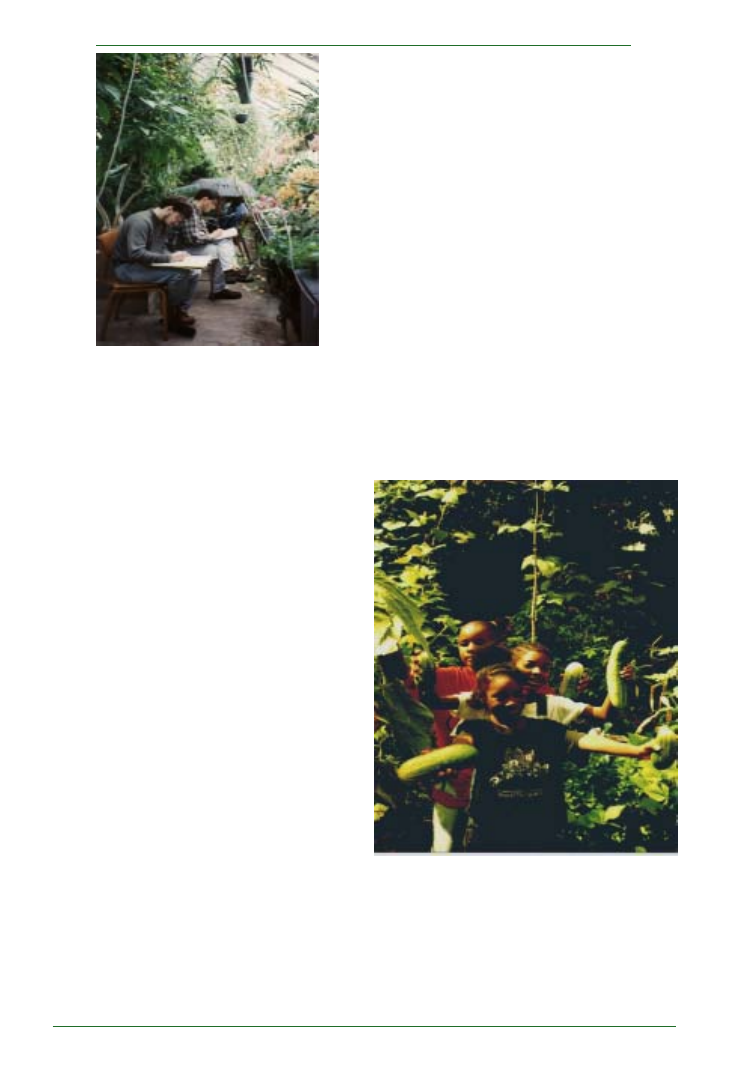
164
Plant Science Bulletin 55(4) 2009
Instead of focusing on generality, we will highlight
the remarkable diversity of plants on many levels.
Flowers that look like goblins (Catasetum
viridiflavum) or parachutes (Ceropegia spp.), and
plant bodies that resemble pebbles (Lithops spp.,
Tricocaulon spp.) or mushrooms (Balanophora
about and discuss emergent properties, such as
environmental engineering by plants, culminating,
on the biosphere level, with the Gaia “hypothesis”
(Margulis and Sagan 2003, Margulis 1998). Plant-
animal interactions will inspire further interest and
teach co-evolution. We will embrace controversy
and use it as a teaching tool. We’ll view the flower,
for example, as what it is—a sex organ—and not
just a bunch of terms to memorize. Our students will
thrill to stories of sex, lies, and flowers: the
Aristolochia and Stapelia spp. that attract flies with
tell-tale visual patterns and rancid smells, or the
orchids that entice male wasps to pseudo-copulate
with them (Peakall 2007). We won’t shy away from
religion either—instead, we’ll celebrate the rich
ethnobotany of sacred plants. For example, when
botanists look at passionflowers (Passiflora spp.),
we see remarkable adaptations for attracting
pollinators, excluding other visitors, and presenting
male and female structures sequentially, all
enhancing pollination (Janzen 1968). But to the 15
th
century missionaries who were the first Europeans
to see them, these same adaptations symbolized
the suffering and crucifixion of Jesus (his passion,
to Catholics; Wikipedia 2009). We’ll teach both
views.
The first step on the journey is awareness. We will
teach our students to see plants as fascinating,
cool organisms—able to do anything an animal can
do and more, but without being able to move from
place to place. For example, plants need to obtain
nutrients from the environment, and what better way
to see this than a carnivorous huntsman’s horn
(Sarracenia leucophylla) filled with flies that have
been lured to their death by the plant’s irresistible
deception! We’ll rescue plants from the prejudice
of torpid tropisms, and let our students discover that
plants have true behaviors (Trewavas 2003). For
example, at a Boys and Girls Club in NYC, my young
students grew passionflowers (Passiflora sp.) from
seed. When the seedlings had developed tendrils,
each student stuck a stick in the soil and placed their
plant’s tendril on the stick to see what would happen.
I thought I would have to engage them in something
else for at least a half hour, but ten minutes later,
their curiosity was so great that we went to look at
the seedlings. Already, the tendrils had started to
wrap around the sticks! For the first time, my
students realized that plants are truly alive, and are
able to sense and respond to their environment.
The sensitive plant or morir y vivir (Mimosa pudica)
is another, easier-to-grow exemplar of plant behavior
that never fails to delight and fascinate students of
any age.
We’ll incorporate cutting edge research into our
teaching. Emerging views of plants as “consortium
organisms” (Margulis and Sagan 2002, Margulis
1998) that are linked underground by vast
mycorrhizal networks, and may even share
resources (Simard and Durall 2004), will continue
to amaze us and our students. Together we’ll learn
Art students observe and draw plants at the Barnard
College Greenhouse in the 1990s.
Young students grow their own gardens and find out
where their food comes from at the Madison Square
Boys and Girls Club in NYC in 1999.

165
Plant Science Bulletin 55(4) 2009
complement—not substitute for—working with real
plants.
spp.) illustrate the extremes of what plants can do.
Mutant varieties, such as Arabian jasmines that
develop corollas-within-corollas (Jasminum
sambac ‘Mali Chat’) or branching within the flower
(J. sambac ‘Grand Duke of Tuscany’), maize plants
bearing kernels and tassels in unusual places (e.g.
tassel seed), and many others form a gallery of
botanical oddities for teaching genetics and
development. The diversity of plant varieties we
have created in agriculture and horticulture reflects
our own history and psychology. Popular books like
“The Botany of Desire” (Pollan 2001) and “The
Orchid Thief” (Orlean 2000) eloquently reveal these
stories.
After gaining awareness, the next step in our
students’ botanical journey will be to connect to the
plants around them. This process becomes
progressively more active through storytelling,
observation, activities, and finally growing plants
and doing inquiry-based botanical science.
Students may connect with the maple tree (Acer
spp.), for example, as a symbol of identity (if they are
Canadian or Native American); through sports (the
recent controversy over maple bats in baseball),
East Asian culture (bonsai), or food (maple syrup).
Observations of plants can happen anywhere: from
the tree-that-grows-in-Brooklyn (Ailanthus
altissima) sprouting out of a crack in the sidewalk,
to your local campus, park, or gardens. So too can
activities like botanical scavenger and treasure
hunts, and art classes. An activity that helps demystify
botanical nomenclature is “Name that Plant,”
developed by the education department at Wave
Hill, a public garden in NYC. After a brief introduction
to how plants are named, students are given a
glossary of botanical Latin terms and several
numbered plants. Students match the plants to
their species names, which describe some
characteristic of the plant, for example Euphorbia
obesa (easy: it’s the fat one) or Dioscorea discolor
(difficult: it’s the one with leaves of subtly-varying
colors). The strongest connection to plants comes
through growing them or doing botanical research,
and we will be sure to incorporate these into our
future curricula. Of course, we will use virtual
technologies like the internet, but these will
Assistant curator Jason Downing with the Marula nut
(Sclerocarya birrea) trees he grew from seed at the
Gifford Arboretum at University of Miami in 2008
In the final step in our students’ botanical journey,
they will develop a sense of inclusion, ownership,
and commitment. This may take place in many
venues: community gardens, outreach programs,
or greenhouses (e.g. Nuestras Raices in Holyoke,
MA); schools and after school programs, or public
gardens. Ownership of plants applies to people of
all ages and backgrounds: at the Gifford Arboretum
at University of Miami where I work as a consultant,
the grounds crew is using open spaces to grow
their own chili peppers and tomato plants. College
students may contribute to (and thereby own a piece
of) plant science as research interns (they should
Undergraduate students Astrid Alfaro and Diane Tole-
do harvest begonias as part of a research internship
for the author’s PhD project in the Biology Department
at University of Miami in 2006.
be paid if at all possible, to include those who need
to work). Ownership will lead to love of plants, and
hopefully, a lifelong commitment to them. We will
make sure our students know about and explore the
many career options in botany, including the
emerging fields of horticulture therapy, plant
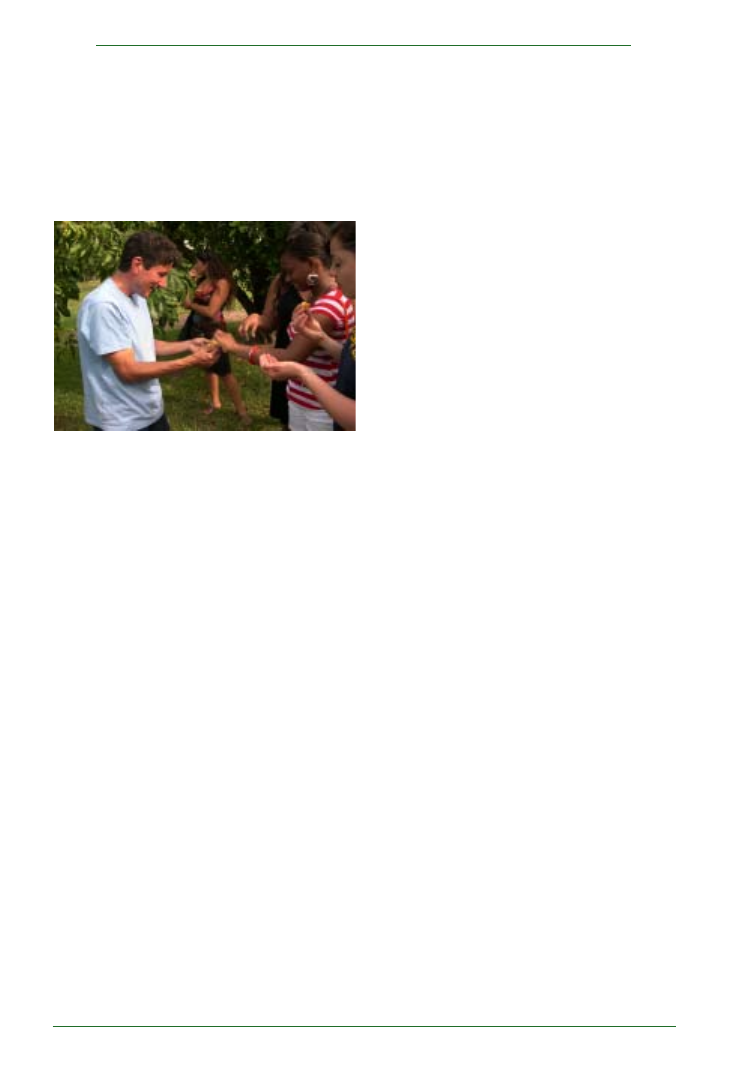
166
Plant Science Bulletin 55(4) 2009
As we encourage and mentor our students to become
aware of, connect with, and own the world of plants,
we will be working together with them to grow a new
green society. Connections with nature are based
on childhood experience, and are being lost with
each successive, more urbanized, generation (Miller
2005). We’ll prepare our students to reverse this
trend, and to explore sustainable new ways to grow
food, manage resources, and achieve social justice.
The future of botany teaching is now!
biotechnology, biological pest control,
bioremediation of wastes, sustainable biofuels,
entrepreneurial horticulture, and local urban
agriculture. We’ll welcome descriptive science
back into graduate training, and cultivate a new
generation of taxonomists to study biodiversity.
Some of us will spearhead a World Biodiversity
Project, which will describe, understand, and
conserve plant (and animal) diversity, especially in
the biological hotspots.
High school students take a tour led by the author of
the Gifford Arboretum at University of Miami in 2008.
This essay is based upon an invited symposium
presentation at the Botanical Society of America
annual meeting, July 26-30, 2008, Vancouver, BC,
Canada.
John Cozza
Department of Biology
University of Miami
1301 Memorial Drive, Coral Gables, FL, USA
jcozza@bio.miami.edu
Web page:
www.bio.miami.edu/john
Gifford Arboretum:
www.bio.miami.edu/arboretum
REFERENCES
Janzen, D. H. 1968. Reproductive behavior in the
Passifloraceae and some of its pollinators in Central
America. Behaviour 32(1): 33-48.
Krugman P. 2009. It’s easy being green. The New
York Times: September 24.
http://www.nytimes.com/
2009/09/25/opinion/25krugman.html.
Margulis, L. 1998. Symbiotic Planet: A new look at
evolution. Basic Books, New York.
Margulis, L. and D. Sagan 2003. Acquiring
Genomes: A theory of the origins of species. Basic
Books, New York.
Miller, J. R. 2005. Biodiversity conservation and the
extinction of experience. Trends in Ecology and
Evolution, 20(8): 430-434.
Nuestras Raices 2008.
http://www.nuestras-
raices.org/.
Orlean, S. 2000. The Orchid Thief. Ballantine Books,
New York.
Peakall, R. 2007. Pollination by sexual deception in
Australian terrestrial orchids.
http://
www.anu.edu.au/BoZo/orchid_pollination/
Pollan, M. 2001. The Botany of Desire. Random
House, New York.
Simard, S. W. and D. M. Durall 2004. Mycorrhizal
networks: A review of their extent, function, and
importance. Canadian Journal of Botany 82: 1140-
1165.
Trewavas, A. 2003. Aspects of plant intelligence.
Annals of Botany 92: 1-20.
Wandersee, J. H. and E. E. Schussler 1999.
Preventing plant blindness. The American Biology
Teacher 61(2): 82-86.
Wikipedia contributors 2009. Passion flower.
Wikipedia.
http://en.wikipedia.org/w/
index.php?title=Passion_flower&oldid=320602499
Zurich, E. T. H. 2009. Climate Change: Halving
Carbon Dioxide Emissions By 2050 Could Stabilize
Global Warming. ScienceDaily: May 4.
http://
www.sciencedaily.com- /releases/2009/05/
090502092019.htm.

167
Plant Science Bulletin 55(4) 2009
Introduction to Bryophytes. Alain Vanderpooten
and Bernard Goffinet. 2009. ISBN13:
9780521700733. (hardcover US$129.95;
paperback US$52.95) pp. 303. Cambridge
University Press.
The very appropriately titled “Introduction to
Bryophytes” is a delightful book. It is both accessible
and broad. The authors dance from topic to topic
with aplomb. They start with the basics of ecology
and evolution, including a definition bryophytes.
They then spend three chapters describing the
anatomy, morphology, and life history of each of the
three lineages, mosses, liverworts, and hornworts.
Although I am an organismal biologist, I especially
enjoyed the rich detail in these three chapters. The
details on various water conducting tissues alone
make this book worthwhile. The latter half of the
book is ecological, starting from large scale
(biogeography), working down to the details of
physiological ecology, and then deftly finishing with
human impacts on bryophytes. Anyone with even a
passing knowledge of plant biology, even if it is just
based on angiosperms, will be able to quickly read
and learn a lot from this volume.
The scope of this book means that information
occasionally occurs in odd, albeit appropriate,
places. For example, discussion of how far sperm
move from male to female organs is included in the
chapter on biogeography! This makes sense insofar
as we are only told how far male and female plants
Books Reviewed
Developmental/Structural
Introduction to Bryophytes. Alain Vanderpooten and Bernard Goffinet. - Root Gorelick.......................167
Pollen and Spores, Applications with Special Emphasis on Aerobiology and Allergy by Shripad N.
Agashe and Eric Caulton, - Nina L. Baghai-Riding.......................................................................................168
Ecological
Seedling Ecology and Evolution. Leck, Mary Allessio, V. Thomas Parker and Robert L. Simpson (eds)
- Suzanne Koptur..................................................................................................................................................169
Economic Botany
Pecans: The Story in a Nutshell. Manaster, Jane. - Amy Boyd..................................................................170
Genetics
An Introduction to Plant Breeding. Brown, Jack and Peter Caligari. - Carolyn M. Wetzel.....................171
Systematics
Orchids and Orchidology in Central America: 500 Years of History. Carlos Ossenbach. - Joseph
Arditti.......................................................................................................................................................................173
Catálogo de las Plantas Vasculares del Cono Sur (Argenitna, Sur de Brasil, Chile, Paraguay y Uruguay).
Fernando O. Zuloaga, Osvaldo Morrone y Manuel J. Belgrano, eds - Marcel Rejmánek,......................174
The Sibley Guide to Trees. Sibley, David A - Michael A. Vincent.................................................................175
Tropical Plants of Costa Rica: A guide to native and exotic flora. Willow Zuchowski. - Joseph E.
Armstrong..............................................................................................................................................................176
Wildflowers of Wisconsin and the Great Lakes Region. Black, Merel R. and Emmet J. Judziewicz. - Sean
Hoban and Daniel Borkowski.............................................................................................................................177

168
Plant Science Bulletin 55(4) 2009
Pollen and Spores, Applications with Special
Emphasis on Aerobiology and Allergy by Shripad
N. Agashe and Eric Caulton, 2009, ISBN 978-1-
57808-532-3, 400 pages, (hardcover US $109.00),
Science Publishers, Enfield, New Hampshire, USA.
To non-scientists, pollen is considered to be
ubiquitous, fine, dust that is produced by weeds,
trees, and grasses They are usually unaware of the
varied morphology of pollen and spores, and their
usefulness to forensic science, agriculture, plant
evolution and many other disciplines. Throughout
much of the 20
th
century, palynology (the study of
extant and fossil pollen and spores) was used
extensively by oil and coal companies for
biostratigraphy, but with cutbacks in the exploration
industry in the 1980’s this subdiscipline has
substantially diminished. Palynology continues to
contribute today to such diverse fields as plant
systematics and evolution, forensics, agriculture
and allergy medicine.
Shripad Agashe and Eric Caulton’s book entitled
“Pollen and Spores, Applications with Special
Emphasis on Aerobiology and Allergy” emphasizes
two major aspects of palynology: spore and pollen
morphology and procedures for preparation, and
practical applications. Major emphasis is given to
palynologically important plants from India and
Europe, although some attention is given to plant
species from Australia and the United States.
The book begins with two introductory chapters
addressing the early history of pollen studies, such
as the artificial pollination of date palms by ancient
Assyrians around 4000 B.C. Wodehouse’s book on
‘Pollen Grains’ that discusses developments in
palynology throughout the 13
th
– 20
th
centuries, and
Gunner Erdmann’s contributions regarding pollen
morphology in the 20
th
century. This information
helps to provide an overview regarding the
development of palynology.
Chapters three through ten provide a basic overview
of palynology, such as pollen morphology,
development and physiology, and techniques for
processing modern and fossil pollen. Particularly
informative subsections are devoted to the shape
and size classes of pollen grains, exine sculpture,
techniques for preparing modern pollen and spores
for microscopic analysis, step-by-step guides of
recovering fossil palynomorphs from peat, lignite,
coal, and methods of determining pollen viability.
Detailed drawings labeling distal and proximal
views of spores and angiosperm and gymnosperm
pollen are especially helpful. Terms for exine
sculpture elements also are well defined. The
emphasis in these chapters and throughout this
book is on spores and pollen of land plants, rather
are separated from one another, not how the sperm
traveled these distance (up to 3.8 metres in the giant
moss Dawsonia superba). Did the sperm simply
float downhill through rivulets or films of water?
An understated leitmotif of the book is that bryophytes
are different from other plants. We cannot predict
bryophyte diversity from diversity of other plants, nor
vice versa. We cannot predict function from form
based on tracheophyte anatomy. While this is not
surprising, Vanderpooten and Goffinet are justified
in continually gently reminding us of this important
lesson.
This book contains many references, including
several from 2009. It contains a decent index. It
contains a wide array of figures. The only production
issue is with the colour photos, which are included
as a centerfold, and also included as duplicate
monochrome images that are well integrated
throughout the text. The problem is that the colour
versions lack captions even though there was
adequate space to duplicate the captions in the
centerfold. Being overly picky, while there was a
colour photo of the heterotrophic liverwort
Cryptothallus (Aneura) mirabilis, but I was also
hoping for a photo of the heterotrophic moss
Hedwigia microcyathea.
There were some surprises. A few bryophytes can
live and grow in extreme environments, such as
hyperacidity, e.g. the liverwort Jungermannia
vulcanicola at pH 1.9. The authors cite a report of a
moss (Hyloconium splendens) that did well after
being watered for two years with pH 2.5 solution.
However, their non-chalance that these treated
plants had only two-thirds the chlorophyll of controls
was a shock. I would have expected much greater
loss of chlorophyll. I was also shocked by the
authors’ non-chalance at neoteny in mosses,
especially since heterochrony is so often
(erroneously) believed to not occur in plants.
There is also some orthodoxy here. The authors
accept, without explanation, that things that look like
a pair of non-closeable guard cells form a stomata
on the sporophyte of hornworts, but form something
that is not a stomata (instead, a mucilage cleft) on
the gametophyte of the same plant. Is this only to
bolster our prejudice that stomata or homologous
structures are complex enough to only be found in
diploid tissue?
While bryologists may find this book a bit skimpy on
detail, Vanderpooten and Goffinet have indeed given
non-specialist a wonderful introduction to these
extraordinary plants.
– Root Gorelick, Department of Biology, Carleton
University, Ottawa, ON Canada K1S 5B6

169
Plant Science Bulletin 55(4) 2009
Seedling Ecology and Evolution. Leck, Mary Allessio,
V. Thomas Parker and Robert L. Simpson (eds)
2008. ISBN 97-0-521-69466-7 (Paper US$70.00)
514 pp. Cambridge University Press, 32 Avenue of
the Americas, New York, NY 10013.
For most humans, baby animals elicit warm
feelings and happiness, even when their parents
are quite ferocious, scary, or ugly. Baby plants don’t
usually cause the same responses; more often, we
are amazed at how different they look from the adult
plant , and the difference in size between the seed,
seedling, and the adult. Many botanists and
gardeners who cultivate plants from their seeds
feel some excitement when the seeds germinate,
and pleasure when the seedlings grow into juvenile
plants, but we are admittedly a select group. Most
people, however, rely on plants making it through
the seedling stage to grow and provide whatever
crop, product, study object, or ecosystem service is
expected; all of us, therefore, will find much of
interest in this excellent book.
The three editors of this multi-authored volume, all
expert in wetlands and a variety of other topics,
contribute chapters themselves that introduce and
the tie together the many other contributed chapters.
Starting with the more autecological aspects of
seedling biology, then establishing the
morphological, taxonomic, and physiological
foundations, the chapters build to many
considerations of ecology at the population and
community levels. The last part of the book has
several chapters dealing with applications,
invasions, disturbances, and restorations.
than the broader scope of traditional palynology
that includes any microscope organic walled
organism.
Chapters 11-21 illustrate the value of pollen studies
to agriculture, horticulture, forensic science, honey
production, paleoecology, taxonomy, plant evolution
and meteorology. Seven chapters are devoted
exclusively to aerobiology and allergies caused by
mold spores and pollen. These chapters include
the contributions from 19
th
and 20
th
century
aerobiologists, the design, advantage and
disadvantages of various gravitational settling
sampling devices, pollen/spore calendars from
India, Taiwan, Australia, North America and Europe,
and source plants (ragweed, grasses, and birch)
of common allergens. The authors describe how
weather patterns, geographical location, latitude,
elevation, and heredity affect the severity of asthma
and other respiratory problems, and note that pollen
allergies have been recorded in horses, dogs and
other mammals. They show how pollen production
is controlled by duration of flowering, mechanisms
of liberation and dispersal, pollen size, time of
release, and other physiological factors. For
example, higher rates of Ailanthus excelsa occurred
from 4 pm to 10 am with a peak at 6 pm that
coincides with the activity of honeybees (Apis cerana
indica). In comparison, Cyperus rotundus releases
pollen from 4 – 6 am with a peak at 5 am, but its
pollen may remain in the atmosphere for many
hours.
Chapter 12 is devoted to melissopalynology (the
study of pollen in honey) and is especially
interesting. Attention is given to how honey is
made, what makes honey an energy and nutritious
food source, quantity and quality of pollen for
maximum honey production, determining
geographical origin of honey samples, and
pollination management strategies. The shortage
of honeybees to pollinate essential agricultural
crops (almonds, strawberries, blueberries),
throughout the United States and why honey is a
regarded as a medicinal food also are discussed.
For example, the authors note that honey contains
over 25 assorted sugars each one having a different
function in human metabolism as well as an
abundance of amino acids, and enzymes. They cite
authorities who have claimed medicinal properties
for honey, such as to promote healing, slow down
cell aging, and alleviating menstrual pain.
This book will be useful to upper division
undergraduate, graduate and post-doctorate
students and research scientists who want to gain
an understanding of applied palynology, as well as
for educators. For example, I intend to explain and
utilize some of the gravitational sampling devices
discussed in this book in forthcoming environmental
science classes, and will likely utilize some of the
described techniques in my research. Excellent
drawings, tables and maps are provided throughout
these chapters. Color and SEM photographs also
are used to show pollen morphology and plant
features of Ambrosia (ragweed) an invasive plant
from North America that is becoming a nuisance in
Europe. This book is not without flaws; for example,
there are a few misspelled words throughout the
book, as well as taxonomic errors. For example, on
page 89 Anthoceros (a hornwort) is misidentified
as a liverwort. Some of the references cited in the
book are rather dated (prior to 1960), although
references within the last five years are also provided.
Overall, this is a book I would recommend.
-Dr. Nina L. Baghai-Riding, Delta State University

170
Plant Science Bulletin 55(4) 2009
Seedlings are small and vulnerable, and influenced
by many factors that affect their establishment and
growth. The introductory chapter gives us a short
seedling primer, where the parts and their functions
of the typical seedling types are outlined. The
editors/authors also point out that seedlings are but
one part of the plant life cycle, but essential to the
continuity of the species. They introduce the concepts
of filters and safe sites, topics elaborated by other
authors later in the book.
The natural history of seedlings (Leck and Outred)
sets the stage for subsequent chapters on seedlings
in stressful environments and specialized seedling
strategies. The latter chapter (by Whigham et al.)
explores some very interesting groups of seedling
plants (including orchids, parasites, carnivorous
plants). Mostly a review of published works, there
is a temperate bias.
The next section begins with a fascinating chapter
on embryo morphology and seedling evolution, in
which Niklas considers all seed plant groups and
their spore-producing forebears (all embryophytes,
or land plants). Cotyledons went from absorptive to
storage organs. There was a trend from exoscopic
to endoscopic embryogeny, with bryophytes,
sphenophytes, and some ferns having exoscopic
embryogeny, other ferns, all leptosporangiate ferns,
and seed plants having endoscopic embryogeny.
Farnsworth provides insight into the influences of
phytohormones on seedlings; Kitajima and Myers
consider the ecophysiology of seedlings,
considering patterns associated with opportunistic
vs. conservative carbon allocation strategies. They
point out that phenotypic plasticity is under genetic
control, and that seedlings of ‘gap’ species show
more plasticity than seedlings of late successional
species. Horton and van de Heijden examine the
role of symbioses in seedling establishment and
survival, especially mycorrhizal fungi. This chapter
has some very nice figures with photos of both kinds
of mycorrhizae, in nicely labeled diagrams.
The next section of the book (Life History
Implications) begins with a chapter by Moles and
Leishman in which strategies and trade-offs are
reviewed. My two favorite chapters of the book are
in this section (my ecological bias).
In the first of these, Eriksson and Ehrlen discuss
seedling recruitment and population ecology,
reminding us that “a stable population is maintained
if one reproductive individual is replaced, on average,
by one successfully recruited offspring”. With this
in mind, life span should correlate with the rate of
seedling recruitment; short-lived plants should have
greater recruitment rates than longer-lived ones.
They consider various causes of mortality:
herbivores, pathogens, drought, and competition.
They weigh the importance of microsite (safe site)
limitation versus seed limitation.
The next chapter (by Keeley and van Mantgem)
focuses on seedling communities, in the modern
light of community assembly rules (restrictions
based on the presence/abundance of other species,
not simply species-specific responses to the
environment). The null model, that taxa assort at
random, is not valid if there are significant
environmental filters (such as soil type variation,
low phosphorous content, fire, distance from coast)
that lead to non-random combinations of
recruitment patterns. In another chapter, Kollmann
considers functional groups in spatial variation in
seedling emergence and establishment.
The last contributed section examines applications
in invasion biology, anthropogenic habitat
degradation, and restoration ecology. Hyatt writes
that seedling ecology may not be too important in
invasive species, but these invasive species may
have negative effects on native seedlings. Baken
considers seedlings in restoration of dryland
systems, and Dalling and Burslem discuss seedling
responses to human disturbance in tropical forests.
Galatowitsch considers the pros and cons of using
juvenile versus adult stock in ecosystem restoration.
Creating safe sites to promote seedling
establishment is a key to success, keeping in mind
interactions with microbes and herbivores.
The final chapter by the editors puts the seedling
into an ecological and evolutionary context, tying it
all up nicely. The extensive references (108 pages!)
serve to aid readers in following up on topics of
interest, and the index is very useful as well, with
taxa, concepts, and catchwords for locating items
encountered but mislaid.
It is inevitable in an edited, multi-authored work that
there is some redundancy of topics. But overall, this
is an appealing, interesting, and useful book. My
graduate students and I have all found information
of use in our various research projects, and I have
learned some new things to enhance my teaching
in Plant Ecology next spring, both lecture and lab
class activities. I recommend this book
enthusiastically and predict it will be well received
by both general and specialized audiences.
-Suzanne Koptur, PhD, Florida International
University

171
Plant Science Bulletin 55(4) 2009
An Introduction to Plant Breeding. Brown, Jack
and Peter Caligari. 2008. ISBN 978-1-4051-3344-
9 (Paper US$80.00) 209 pp. Blackwell Publishing,
2121 State Avenue, Ames, Iowa 50014-8300.
Plant (and animal) breeders must address many
challenges to ensure a stable human food supply:
increasing population size, climate change, limited
freshwater supply, ecological degradation,
constantly evolving pests and pathogens, and
nutritional value (Levine 2009, Evanson and Gollin
2003). To do so, current and future plant scientists
need a strong grounding in evolution, botany,
genetics, pathology, statistics, molecular biology,
management, and nutritional science. The authors
of “Plant Breeding” have written an admirable text
that touches on all of these topics but focuses on
genetics and statistical analysis. In spite of several
flaws, this useful and enlightening book will help
train plant scientists to engage with practical
concerns such as selection, heritability, and
experimental design.
The first two chapters provide a crash course in
evolution, history of agriculture, and basic plant
reproductive biology. A thorough understanding of
Pecans: The Story in a Nutshell. Manaster, Jane.
I2008 SBN 978-0-89672-640-6 (104 pages, Paper,
$19.95) Texas Tech University Press.
As Americans prepare for Thanksgiving meals
featuring native foods such as turkey, cranberries,
and corn, the time is ripe for exploring one of our best
native nuts, the pecan. Pecan: The Story in a
Nutshell is a charming little book presenting an
interdisciplinary, albeit agriculture-focused, look at
this fruit native to river bottoms along the Mississippi
and throughout eastern Texas.
This very readable account includes information on
the pecan’s range, botanical niche, agricultural
history, ecology and nutrition. Manaster begins with
the etymology of the word “pecan”, including the
cultural variations in its pronunciation. She
discusses the historical and current range of the
species, including both native and planted trees,
stretching from the coast of South Carolina and
Florida west to Arizona and California, south into
Mexico and north along the Mississippi into Illinois
and Iowa.
The chapter entitled “Botanical Niche” discusses
the evolutionary history of the species and its hickory
ancestors, and includes accounts of its botanical
nomenclature. Manaster describes the bark, leaves
and fruits of the pecan (leaving her description of the
flowers, inflorescences and breeding system for
the chapter on cultivation), and includes information
about habitat and environmental needs and how
they impact crop production.
I found the chapter on “History” to be one of the most
engaging parts of this book. Manaster has clearly
done extensive research on historical accounts of
the pecan and shares it with us here, from Native
American uses, through European exploration and
accounts from botanists such as Michaux and
Bartram, to early cultivation efforts. She follows this
chapter with an even more detailed account of the
history of pecan cultivation and breeding throughout
the southern United States, which is then followed
by more specific information about the history of
pecan cultivation in the state of Texas.
The chapter entitled “Orchards” then takes us up to
the present, describing more about the ecological
needs of pecan trees and how they are met
agriculturally in orchards from Florida to Arizona.
This includes information about site selection,
choosing protandrous and protogynous varieties,
diseases, and methods of harvest. This is followed
by a chapter about threats from animal predation
and methods of control.
Manaster then returns to the historic account with a
chapter on the pecan industry, touching on the
economics, trade history, advances in processing
(shelling) and refrigeration, as well as labor history.
In the final part of the book, she covers nutritional
content of the nuts and shares recipes for classic
pecan delicacies such as pralines and pecan pie.
In summary, this quick read is enjoyable, full of
interesting historical anecdotes and photos
alongside details of cultivar development. It is not
technical enough to serve as a cultivation reference
for orchard growers, but instead presents a breadth
of knowledge about this beloved American crop and
its history for a wide audience.
—Amy Boyd, Dept. of Biology, Warren Wilson
College, Asheville, NC

172
Plant Science Bulletin 55(4) 2009
also benefit from chapter-length case studies
organized by crop, as in Breeding Field Crops
(Sleper 2006), which provides separate chapters
each for potato, sugarcane, sorghum, and others.
Further, there is only minimal attention given to the
roles of whole genome sequences and DNA
fingerprinting in modern plant breeding. This last
omission is especially surprising considering the
authors advanced treatment of genetic theory.
A more pressing issue for at least some readers is
that there are fewer than ten citations in over 200
pages of text, and there are no lists of relevant
literature for future readings. For most uses of this
book, from a practical handbook to classroom
training, some list of references will help the reader
to explore a topic in greater detail. It is also confusing
that the authors include a conclusion section for the
first few chapters but not for later chapters. Most
readers would appreciate a summary of the
techniques learned, their applicability, and future
prospects. Lastly, lack of a glossary, while not a
fatal flaw, sets this text a step below more complete
books.
The weaknesses of “Plant Breeding” may frustrate
some readers. However, the content, especially
the central chapters, is an excellent source for
students of plant genetics and biometry, as well as
advanced practitioners. The opportunity to work
through statistical procedures is especially
informative. Perhaps in later editions the authors
will expand their text with more captivating case
studies, a list of references, and an exploration of
other topics in plant breeding, such as ecology,
pathogens, or agribusiness. A very intriguing and
relevant additional topic would be how recently
developed methods of targeted gene modification
(Porteus 2009) will alter plant breeding. With some
improvement, “Plant Breeding” could be both an
essential introduction and a handy toolkit for all
agricultural scientists.
References:
Evenson, R. E. & D. Gollin, 2003 Assessing the Impact of
the Green Revolution, 1960 to 2000. Science 300, p758-
762.
Levine, A. S. 2009 “Agriculture” Is Not a Dirty Word.
Science 324, p1140.
Porteus, M. H. 2009 Plant biotechnology: Zinc fingers on
target. Nature 459, p337-338.
Sleper, D. A. 2006 Breeding Field Crops. Wiley-Blackwell
Stokstad, E. 2009 The Famine Fighter’s Last Battle. Science
324, p710-712.
-Sean Hoban, Department of Biological Sciences,
University of Notre Dame.
the text, particularly plant reproductive biology, and
beginners should spend substantial time here.
The third chapter introduces objectives of a breeding
program, such as usable yield, end-use quality,
and pest resistance. The core of the book falls
within chapters 4 through 7, which cover breeding
schemes, genetics, predictions, and selection.
This includes fundamentals of plant genetics,
(selfing, heterosis, quantitative traits) while also
addressing decisions a plant breeder must make,
such as predicting the outcome of a cross or
choosing the parent plants to retain during each
stage of selection. The final two chapters are an
assortment of topics and alternative techniques in
plant breeding (such as induced mutation,
interspecific hybridization, and molecular markers)
as well as considerations for putting theory into
practice (such as experimental design and data
collection). Throughout the book, the reader is
treated very well in terms of topic selection, as
chapters lead intuitively from one to the next, i.e.
genetics before predicting inheritance of traits, and
inheritance before methods of selection.
The chapters on genetics (Chapter 5) and selection
(Chapter 7) are especially valuable, and could
serve as supplementary readings for a more general
course in plant science or genetics. The authors
provide a challenging yet accessible introduction to
segregation, linkage, pleiotropy, epistasis, and
tetraploid inheritance. Further, the reader can work
through several detailed practice problems for
appropriate statistical procedures, beginning with
Chi-square and advancing to Griffing’s analyses of
combining ability. Equal attention and care are
given to selection indices, gene x environment
interactions, quantitative genetics, error, crossing
design, and decisions during successive stages
of selection. Several techniques are described in
detail, such as the Scottish Crop Research Institute
scheme for breeding potatoes (pp 54-55) and a
challenging program of developing multiple desired
characters in wheat (pp 127- 128). Helpfully, the
authors frequently give practical advice, provide
instructions for interpreting results of statistical
tests, and summarize the techniques introduced.
Topics are discussed in a manner that is thorough
enough for a beginner to absorb (albeit with a bit of
page-flipping), and also presents possibilities for
the more advanced reader.
Unfortunately, while strong in the aforementioned
areas, “Plant Breeding” warrants some criticism.
The authors never make use of side boxes or case
studies set apart from the main text, which would be
of interest to many readers. An excellent model for
an interesting side box would be Stokstad (2009),
an article on Norman Bourlag and the development
of resistance to wheat stem rust. Readers might
these fundamentals is crucial for the remainder of

173
Plant Science Bulletin 55(4) 2009
Orchids and Orchidology in Central America: 500
Years of History. Carlos Ossenbach. 2009. ISSN-
1409-3871. Soft-cover, 268 pp. Lankesteria,
International Journal on Orchidology,Vol. 9, No. 1-
2, August 2009, University of Costa Rica, San Jose.
It is not uncommon for orchid growers to develop a
hobby within a profession or an avocation.
Photography, painting, line drawing, book collecting
and travel are common choices. A scholarly
undertaking like delving into the history of orchids,
especially in a manner which leads to publication
in a peer reviewed journals, is less common. Carlos
Ossenbach, an architect, has been doing just that.
His first major contributions in journals
(Ossenbach, 2005, 2007) dealt with the subject
from pre hispanic times until approximately 1870.
That was no easy feat because in its zeal to convert
the local population the Catholic Church destroyed
many documents. A sad and cruel example is an
Auto da Fe in which Diego de Landa (1524-1579),
a now infamous Franciscan, destroyed 27 rolls of
Mayan codices which according to him were “work
of the devil”: “Fray Diego de Landa throws into the
fire, one after the other, the books of the Mayans. The
inquisitor curses Satan, and the fire crackles and
devours. Around the incinerator, heretics howl with
their heads down. Hung by their feet, flayed with
whips, Indians are dowsed with boiling wax as the
fire flares and the books snap, as if complaining.
Tonight, eight centuries of Mayan literature turn into
ashes” because Landa could not read them and
described as “work of the devil” (one is reminded of
the destruction of ancient statues by the Taliban in
Afghanistan some years ago). Still, Ossebach
managed to piece together an interesting historical
account.
Some of the same history, but in more detail
(including the quotes above) is at the start of this
volume. The historical narrative proceeds from
there chronologically. Ossenbach places orchid
history in the broad historical context not only of
Central America, but of the entire continent and tells
a rich and fascinating story. Without his scholarship,
ability to locate and use rare and interesting
illustrations, and storytelling gifts, it is hard to even
imagine, let alone realize, that the Alamo, the
Panama Canal, the California gold rush, the
Mexican-American war and an Englishman from
Sheffield who settled in Saint Louis (Shaw) all
affected orchid history.
Central American orchids are beautiful and
fascinating. The individuals who collected and
studied them may not be beautiful or even attractive,
but they are fascinating and intriguing. They include
a individuals such as: George Ure Skinner (1804-
1867), a respected merchant in his day who also
collected orchids and corresponded with William
Jackson Hooker, the Director of the Royal Botanic
Gardens, Kew; Josef Ritter von Rawiez Wascewicz
(1812-1866), a Pole who spoke “a mixture of
Spanish and Polish” and was “all hair, from his
nose downwards;” Benedict Roezl (1824-1884) a
Bohemian who was a “passionate mixture of
ambition and madness;” Oakes Ames (1874-
1950) who came from “a cultivated and wealthy
family in New England,” graduated from Harvard
and became director of its Botanical Museum;
Alphonse Henry Heller (1894-1973), a wealthy
American who lived in Nicaragua, and many others.
Ossenbach tells all of their stories, describes their
activities, places them in the general historical and
economic perspective of the continent and in most
cases includes a likeness. He does that in a manner
which makes for engrossing and pleasurable
reading. His history reads like a novel or a series
of vignettes about eccentric and wonderful
characters. He leaves out several juicy details which
circulate in the orchid community despite questions
or at least uncertainties about their veracity, but this
only adds dignity to his book and increases his
stature as an orchid historian and a scholar (who is
a prominent architect in Costa Rica in everyday life).
Ossenbach’s history is a double issue of a journal,
but in reality it is a book which should be of interest
not only to orchid growers, enthusiasts and
scientists, but to all those who are interested in the
historical perspectives of plant exploration,
collecting and shameless exploitation. At about
$26 (the subscription price for a volume of
Lankesteriana) it is also a bargain
Literature Cited
Ossenbach, C. 2005. History of orchids in Central
America Part I: From prehispanic times to the
independence of the new republics. Harvard Papers
in Botany 10: 183-226.
Ossenbach, C. 2007. History of Orchids in Central
America Part II: The NewRepublics,1821-1870.
Selbyana 28: 169-209.
-Joseph Arditti, Professor of Biology Emeritus,
University of California, Irvine.

174
Plant Science Bulletin 55(4) 2009
Catálogo de las Plantas Vasculares del Cono Sur
(Argenitna, Sur de Brasil, Chile, Paraguay y
Uruguay). Fernando O. Zuloaga, Osvaldo Morrone
y Manuel J. Belgrano, eds. 2008. ISBN 978-1-
930723-70-2(hardcover, 3. volumes, US$375.00).
3348 + xcvi pp., Missouri Botanical Garden Press,
St. Louis.
Catalogues and checklists of biota living in particular
terrestrial or marine regions represent a backbone
for our assessments of the Earth’s biodiversity. For
South America, we have several catalogues of
vascular plants growing in individual states or other,
relatively speaking, small areas(e.g., Argentina,
Chile, Ecuador, Guiana Shield, Mato Grosso, Peru,
Venezuela). Unfortunately, so far we do not have any
catalogues for the three extremely species rich
staes: Bolivia, Brazil, and Colombia. The catalogue
for Bolivia will be available soon (P. M. Jørgensen
& al.,in press) but for the other two we will have to
wait some time. Now, however, we have a catalogue
for the southern part of South America – the Southern
Cone. The catalogue under review covers 4,708,617
km
2
, representing about 26% of the surface of the
continent. It includes Argentina, Chile, Paraguay,
Uruguay, and the three southern states of Brazil
south of parallel 22
0
S (Paraná, Santa Catarina, Rio
Grande do Sul).
Since 2001, this project has been coordinated at the
Instituto de Botánica Darwinion, Buenos Aires, in
collaboration with the Missouri Botanical Gardens,
St. Louis, botanical institutions in all Cono Sur
countries, and more than 200 contributors from
different centers of botanical research. Execution of
this project utilized the database IRIS , that was
created and developed in the Instituto de Botánica
Darwinion, Buenos Aires. Continuously updated
electronic version of the Catálogo is now available
at:
http://www.darwin.edu.ar/Proyectos/
FloraArgentina/FA.asp
. It allows for fast search of
information about individual species with links to
detailed bibliographical references. The Introduction
(in both Spanish and English) presents a
description of the biogeographical regions in the
area and, in nine tables, extensive numerical
analyses of the flora.
In three volumes of this catalogue, 17,697 accepted
species are listed alphabetically by families (308)
and genera (2586), documented with
bibliographical citations, references to herbarium
specimens, information on their distribution, habit,
native status, elevation ranges, and synonymy.
More than 42,300 synonyms are treated in this
catalogue. There are 7691 endemic species in the
Southern Cone (46.3% of native flora). Comparison
with two other large areas of the Southern
Hemisphere – Australia and Southern Africa
(Namibia, Botswana, South Africa, Swaziland,
Lesotho) - puts the species richness of the Cono
Sur flora into a broader perspective (Germishuizen
& Meyer 2003, Hnatiuk 1990).
Area (km
2
)
Native Naturalized
Species Species
Australia
7,617,930 15,638 1,952
Cono Sur
4,708,617 16,599 1,098
Southern Africa
2,693,422 20,073 882
Even if flora of Australia may be in fact by 15% richer,
it is clear that, considering differences in areas,
species richness of the Southern Cone is
intermediate between Australia and Southern Africa.
The Catálogo de las Plantas Vasculares del Cono
Sur is a monumental achievement. It will be an
irreplaceable source of information for all botanists
working in South America.
– Marcel Rejmánek, Department of Evolution and
Ecology, University of California, Davis, CA 95616.
Literature Cited
Germishuizen, G. & N.L. Meyer, eds. 2003. Plants of
Southern Africa: An Annotated Checklist. National
Botanical Institute, Pretoria.
Hnatiuk, R.J. 1990. Census of Australian Vascular
Plants. Australian Government Publishing Service,
Canberra.
Jørgensen, P.M. et al., eds., in press. Catálogo
de las Plantas Vasculares de Bolivia. Missouri
Botanical Garden Press, St. Louis.
“Botany I rank with the most valuable sciences”
-Thomas Jefferson

175
Plant Science Bulletin 55(4) 2009
The Sibley Guide to Trees. Sibley, David A. 2009.
ISBN 978-0-375-41519-7 (Flexibound, US$39.95)
426 pp. Alfred A. Knopf, New York, NY.
I am only a casual bird-watcher, but among those
bird guides I do possess, most are written by David
Sibley. I have used them happily (and I might even
say, successfully) to identify birds when I am out-
and-about doing my botanical pursuits. So it was
with great anticipation that I awaited the publication
of Sibley’s tree guide. I cannot say I am disappointed.
The Sibley Guide to Trees is a relatively small
volume, measuring 25 X 16 cm, a good size to carry
in a backpack in the field. It contains illustrations
and/or descriptions of most native and naturalized
species of trees in North America, and many
commonly (and some less-commonly) cultivated
tree species; over 600 species are discussed to
varying degrees in the text, and there are over 4100
illustrations in the volume. The book begins with
about 30 pages of introductory material, covering
such topics as making observations, recognizing
patterns, understanding cultivated trees and their
potential impact on ecosystems, and valuing
taxonomy as a science. Following this, Sibley
discusses taxonomic hierarchies of plants, how
his maps are constructed, and conservation issues.
His introduction concludes with a thorough overview
of a wide range of morphological characteristics
that are used in the identification of trees, many of
which are illustrated. The remainder of the volume
is coverage of tree species, arranged by families.
Families in the guide are arranged phylogenetically,
beginning with gymnosperms, followed by the
monocots (palms, Yucca), and then the “dicots”.
The dicots follow in a more-or-less APG
arrangement, beginning with Lauraceae and ending
up with Adoxaceae. Nomenclature used throughout
is mostly up-to-date, and common names are given
for all species. There is a checklist a la a birder’s
life list toward the end of the volume, followed by a
complete species index.
Species coverage in this book is quite thorough. For
example, all 8 species of Magnolia included in the
FNA treatment for the genus are covered in Sibley’s
book, as are two commonly cultivated species.
Among the oaks (Quercus spp.), of the 90 species
covered in the FNA treatment (some of which are
shrubs), 68 native and 8 cultivated species are
treated by Sibley. Some less common species
which I might consider trees are excluded, such as
Jacquinia (Theophrastaceae), but these tend to be
species of very restricted range. Discussion of
species that escape is good, as exemplified by the
coverage of Acer ginnala, Eucommia ulmoides,
Pyrus calleryana, and Tetradium daniellii, all of
which are species I see escaping in the eastern
United States. Some genera are not as completely
covered, such as Crataegus and cultivated
crabapples.
Descriptions are given for most species, and are
generally very good. The usual descriptive
characters are given, including whether the species
is deciduous or evergreen, something about its
size, and some traits that can be used to distinguish
among similar species. Characters of flowers,
fruits, bark, and twigs are often included, and
subspecific taxa are sometimes distinguished.
Most species are given a page or half-page, with
less common or more restricted species given
less. Illustrations and maps are included for most
species. In some groups, distinctive characters
(such as circular stipule scars in Magnoliaceae)
are not mentioned. The treatment of Fraxinus omits
some good traits to distinguish some of the species,
such as petiole scar shape or branching patterns.
But, overall, the descriptions are quite useful.
Since many are already aware of Sibley’s bird
illustrations, the quality of the illustrations in this
volume should be discussed. Generally, color
illustrations are given for leaves, flowers, fruits,
twigs, and sometimes bark or habit. The illustrations
are fairly small, and some characters can be difficult
to see, but, by and large, the illustrations are of good
quality and show essential characteristics
necessary for identification. They are often
augmented by descriptive phrases that accentuate
a given, sometimes definitive or helpful, trait.
Considering the difficulties that might present
themselves when painting bark, for example, the
pictures are very good, and for the most part very
useful. In my opinion, they do not live up to the quality
of his bird paintings (those birds are just so gaudy!),
but are none the less quite effective. Great pains
appear to have been taken to show colors and
surface features on what could have been presented
as plain green leaves.
Distribution maps are provided for many of the
species in the book. These appear to have been
carefully researched, and give a very good
approximation of the distributions of many of the
species. Those for some species, however, do not
adequately represent the range of the species,
such as the map given for Pinus sylvestris, which
would lead the reader to believe that the species is
not known from the western US or Canada.
I can find very little to criticize in this nice volume.
There is the occasional nomenclatural point with
which to disagree, or map with which to argue, or a
branch put in upside-down, but beyond that, I can
find little of substance that should be corrected. The
one major, glaring omission, in my opinion, is the

176
Plant Science Bulletin 55(4) 2009
Tropical Plants of Costa Rica: A guide to native and
exotic flora. Willow Zuchowski. 2007. Zona
Tropical Publication, Comstock Publishing
Associates of Cornell University Press, Ithaca and
London. 529 pp. Cornell ISBN 0-978-8014-7374-
6.
As a frequent botanical traveler to Costa Rica,
either to conduct field research or as an instructor
for our annual rainforest ecology field trip, I am
always interested in new field guides for Costa
Rican biota. Distracted as I was by sabbatical leave
travel and the time demands of domestic field
research, I had not yet seen the 1
st
edition, then the
Cornell edition I sent for review was lost in the mail,
but fate intervened and I received a copy from a lucky
colleague who had won it as a door prize.
Like any other tropical country, the plants readily
observed in Costa Rica are a mixture of native and
exotic species, and the author of this guide tried,
and largely succeeded, in selecting prominent,
important, and conspicuous plants for inclusion,
resulting in well over 400 species in 124 families of
vascular plants. Each entry is illustrated with quite
good to excellent color photos, and here and there,
useful B&W diagrams showing details of flowers,
fruit, or vegetative structures. Each description
includes the scientific name, common names in
both Spanish and English, the family name, an
accurate physical description, flowering and fruiting
seasons, the geographic distribution, habitats, and
altitude, related species, and comments. The
author dispenses a considerable amount of
informative botanical knowledge in the “comments”
section. The many interesting eclectic tidbits
presented include information about the pollinators
and pollination biology, indigenous uses of the
plant, mutualistic interactions, the origins of either
the scientific or common names, conservation or
problems (if an exotic), toxins and their medicinal
values, if any, and organisms that consume the
fruits and seeds. This is great material, real biology
delivered in a field guide.
Of particular note are the many “essays” sprinkled
here and there throughout the book where the
author provides some brief exposition (1 or 2 pages)
of detailed knowledge about botany, for example,
the pollination of figs by fig wasps, members of the
coffee family Rubiaceae, tropical cacti, mahogany
and rosewood, gap specialists, and, my favorite,
drift seeds (seeds and pits often found on beaches).
In addition to knowledgeable comments, these
interludes demonstrate the author’s extensive
knowledge, as does the extensive bibliography,
however, without citations in the text, there are no
connections to these references and publications,
and as an educator, I find that very unfortunate.
In my experience Costa Rican naturalists are quite
good, but often quite vertebrate oriented, and this
may well be because better field guides and more
information has been available for mammals,
reptiles, and birds. No doubt many naturalists will
incorporate more botany now that they have a ready
source of material.
I could quibble a bit here or there about the plants
chosen for inclusion, but generally the author
demonstrated well-informed decisions in selecting
plants for inclusion. One seemingly obvious
omission I noted was a failure to mention the stilt
palms of the wet Atlantic lowlands, but this was
rectified by including these oddly conspicuous
plants in a special section on palms. And this
brings me to my only serious criticism, the system
of organization.
Not being a stickler for taxonomic organization, I
take no offense from books that organize wild
flowers by season or flower color, for example.
Unfortunately in the words of the author herself “A
guide to the tropical plants of Costa Rica incorporates
several different organizing principles”. This was a
mistake because not only do you not know where to
look for some plants, you must constantly check in
lack of a key to the species, or at least the genera,
included in the book. While this may limit its
usefulness in a college botany class (or not), it is not
a fatal flaw.
This book is so thorough and so well written that I
think it will prove very valuable in many venues, and
for many people. I can see it in use in a high school
botany class, as a guide for any natural area or park,
as a guide for birders, or for anyone else interested
in trees, from the rank amateur to the “hardened
professional.” It is wonderful to have a single-
volume guide to trees that covers the whole continent,
and that covers both native and introduced species.
Now, if only David Sibley can be convinced to write
a companion “Sibley Guide to Shrubs and Woody
Vines”!
— Michael A. Vincent, Department of Botany, Miami
University, Oxford, OH, USA

177
Plant Science Bulletin 55(4) 2009
Wildflowers of Wisconsin and the Great Lakes
Region. Black, Merel R. and Emmet J. Judziewicz.
2009. ISBN 978-0-299-23054-8 (Paper US$29.95)
320 pp. University of Wisconsin Press, 1930 Monroe
Street, 3
rd
floor, Madison, WI 53711-2059.
As the introduction of “Wildflowers of Wisconsin
and the Great Lakes Region” states, field
identification guides are for “those who want more
than to just enjoy the beauty.” They are for those who
“want to name them accurately, understand how
they relate to one another, and gain awareness of
the ecological context (p xi).” Such books are for
(whether in name or in heart) botanists, ecologists,
taxonomists, and naturalists. The best guides are
accessible to a novice, but also sufficiently detailed
for veteran outdoorsmen. Although “Wildflowers” is
remarkably thorough, and still small enough to take
to the field, it has some flaws in content and
accessibility that keep our enthusiasm bridled and
ultimately make the book not quite first rate.
We’ll start at the beginning. In keeping with their
ecologically minded goals, the authors thoughtfully
include one page descriptions of 20 native habitats/
ecosystems found in Wisconsin. This useful
overview presents the relative contribution of each
of these habitats to the whole of Wisconsin, and a
list of flowers and other plants likely to be found in
these environs. The section gives context to the
flowers, illustrating that they exist as just one piece
within a large mosaic of other plants, animals, and
abiotic factors. However, this section does not
capture the fine scale with which communities often
are defined, and ecologists may feel miffed. While
they list 20 community types, the Natural Heritage
Inventory Natural Community Descriptions (Epstein
2008) lists approximately twice that. A thorough
survey of community types occurs in Elizabeth
Thompson and Eric Sorenson’s (2000) Wetland,
Woodland, Wildland: A Guide to the Natural
Communities of Vermont, and serves as an example
several different groupings. Like many field guides,
this one works best if you already know what the
plant is.
The book is organized into eight chapters, some
with several subsections: 1. Painted Treetops
(common trees with showy floral displays), 2. Other
Common Trees (those lacking colorful floral
displays), 3. Roadside and Garden Ornamentals,
4. Fruits and Crops, 5. Living Fences and
Reforestation (woody species used to construct
fences, which often sprout and grow, and those
grown in plantations), 6. Special Habitats (wet
Atlantic lowlands, Tortuguero canals, seasonal dry
forest, montane cloud forests, beach and
mangroves), 7. Typical Tropical Groups (aroids,
bromeliads, palms, heliconias and birds of
paradise, orchids, ferns and lycophytes (which
means clubmosses, but horsetails were included
too), 8 Conspicuous Grasses (mostly roadside
species). Obviously the systematic groups in chapter
7 intersect habitat and uses groupings at right
angles. For example, all of the typical tropical
families are quite common in the wet Atlantic
lowlands and the montane cloud forests, so you
have to look in at least two places, if you recognize
the plant as say a bromeliad. This places several
quite common and conspicuous plants of the wet
Atlantic lowlands in Chapter 7 under aroids, palms
(the stilt palm), heliconias, orchids, and ferns. A
novice who is not familiar with these taxonomic
groups is quite likely to miss plants so placed.
Sorry, but you cannot have it both ways. Even then
some plants fall into more than one chapter, for
example, Spondias are used for living fences and
are grown for their scantly fleshy tart fruits. Similarly
the pejibaye or peach palm could be placed under
fruits and crops or the wet Atlantic lowlands, but it
was placed in palms. On the plus side the brief
introductions to these families are quite good.
Seldom has color photography been used so
effectively to illustrate a field guide. The
photographer, Turid Forsyth, demonstrates a great
eye for detail and effective presentation. Many are
among the best photographs I have seen of some
of these plants, and if you have not tried to take good
photos under the many exacting conditions of the
tropics, you will not understand this achievement.
The more sophisticated will be disappointed by the
number of pages “wasted” on UTF – ubiquitous
tropical flora, those ornamental species that have
been spread around the world to provide a certain
colorful monotony to tropical landscaping. Having
vented my UTF frustrations, inclusion of these
species will doubtless satisfy the curiosity of the
less botanically experienced travelers. My students
always get a huge charge out of Spathodea
campanulata, the African tulip tree, not because it is
pollinated by perching birds seeking a reward of
water, but because the large fluid-filled flower buds
can be used to squirt someone.
On the whole this is a very good, very useful field
guide for a country where a reasonably accessible
and non-technical introduction to botany and plants
is most welcome. However, at just over 900 g (2
lbs), this is a mighty hefty addition to your backpack.
—Joseph E. Armstrong, Professor of Botany and
Head Curator of the Vasey Herbarium, School of
Biological Sciences, Illinois State University,
Normal, Illinois 61790-4120.

178
Plant Science Bulletin 55(4) 2009
of a guide that has the right amount of detail to
approach the topic of communities.
The utility of a field guide depends heavily upon the
structure of the identification keys. Unfortunately,
this is the weakest aspect of “Wildflowers of
Wisconsin”. The authors differentiate plants based
on the number of “parts”, with the definition being
“the obvious or showy parts of the flower including
the sepals and/or petals, but sometimes parts also
include the bracts or upper leaves” (p 1). This is very
easy for some flowers, i.e. Trillium (p 37, 38), but
many flowers will not be so easy, i.e. the prairie-
clover (Dalea, p 129). Granted, it is always tricky
when designing an identification key. Sometimes a
break with tradition is welcome and fresh, and
some readers may like the guide in “Wildflowers”.
However, this arrangement made identification more
difficult for us than the standard character-keys
found in guides such as Newcomb’s (1989)
Wildflower Guide.
Once the reader finds a species of interest, an
informative and concise summary of the flower
awaits them. Each entry takes about one-quarter of
a page, and leaves the reader satisfied they have
keyed out the correct flower. The descriptions are
excellent, beginning with the general plant form-
hairiness, tendency to branch or form rhizomes,
height, annual or perennial. This is followed by
descriptions of flower, leaf, fruit, habitat, and more.
For example, the entry for the Devils paintbrush
(Hieracium aurantiacum) gives descriptive
characteristics, ecological status (introduced), and
life history characteristics (like blooming time), and
even informs the reader that people often mistake
it for “Indian paintbrush” (p 193).
Each species also has an approximately one inch
square full color photo of the whole plant, the flower
or both, an attractive feature to any reader but
especially to first-time field botany students. Adjacent
to the photo sit easily interpreted symbols, indicating
whether the plant is invasive, poisonous, or both.
Both photos and descriptions are extremely well
chosen to point out distinguishing characteristics,
and to our limited expertise they typify normal field
specimens. Granted, though, the photos are not as
large or vibrant as the National Audubon Society
(2007) Field Guide. Next to each photo is a thumbnail
size county map of Wisconsin, indicating reported
occurrences of the flower. However, no other states
are included, even though the book is subtitled “and
the Great Lakes region,” so those of us in Indiana
are unable to make use of this tool.
The guide is especially appealing to students for
several small but useful additions. We were
especially pleased with the inclusion of many
invasive species, such as multiflora rose (Rosa
multiflora) and Eurasian water-milfoil (Myriophyllum
spicatum), right next to their native, related
counterparts (p 168). The authors have taken
special care to describe how to distinguish related
plants, such as the common tansy (Tanacetum
vulgare) from the Lake Huron tansy (Tanacetum
huronense), with distinguishing features in bold
print (p 226). (It would be nice if the authors had
included where the invasive species originated.)
The word glossary introduces the reader to beginner
terms such as entire, bulb, colony, drupe, and more
advanced ones like pappus and corymb. The
pictorial glossary shows various leaf shapes such
as arrow, halbard and heart, as well as features like
bract, stipule, and tendril. Another fun feature (for
beginners and experts alike) is the origin of the
scientific names. For example, the hooker’s orchid
(Platanthera hookeri), is named for Sir James
Hooker (p 23), and American red raspberry (Rubus
idaeus), “of Mt Ida in Crete where Jupiter was hidden
as an infant (p 168).”
The work does “increase knowledge and
awareness of the diversity and beauty of the
wildflowers that surround us every day (p xi).” Its
main drawback is that many readers may find
Wildflowers of Wisconsin difficult to work with due
to the confusing identification key. However, the
book’s aesthetics and more than extensive inventory
make this a strong compliment to other guides
such as Newcomb (1989). We certainly both enjoyed
leafing through it and look forward to our next
encounter with flowers in the fields and woods.
-Sean Hoban and Daniel Borkowski, Department of
Biological Sciences, University of Notre Dame.
References
Epstein, Eric, Emmet Judziewicz and Elizabeth
Spencer. 2008. Wisconsin Natural Heritage
Inventory: Recognized Natural Communities.
Updated 10/13/2008, accessed 8/31/2009.
http://
d n r . w i . g o v / o r g / l a n d / e r / c o m m u n i t i e s / p d f s /
communities.pdf
National Audubon Society. 2007. National Audubon
Society Field Guide to North American Wildflowers:
Eastern Region. Knopf-Doubleday Publishers.
Newcomb, Lawrence. 1989. Newcomb’s
Wildflower Guide. Little, Brown, and Company,
Canada.
Thompson, Elizabeth H. and Eric Sorenson. 2000.
Wetland, Woodland, Wildland: A Guide to the Natural
Communities of Vermont. The Nature Conservancy
of Vermont and the Vermont Department of Fish and
Wildlife, Vermont, USA.

179
Plant Science Bulletin 55(4) 2009
Books Received
If you would like to review a book or books for PSB,
contact the Editor, stating the book of interest and
the date by which it would be reviewed (15 January,
15 April, 15 July or 15 October). E-mail
psb@botany.org
, call, or write as soon as you notice
the book of interest in this list because they go
quickly!
Note that books in green are already in
review and no longer available.
Books received are
now posted on the web site as they become available
and may be requested as soon as they are posted.
- Editor
The Alga Dunaliella: Biodiversity, Physiology,
Genomics and Biotechnology. Ben-Amotz, Ami,
Jurgen E. W. Polle, and D. V. Subba Rao (Eds.)
2009. ISBN 978-1-57808-545-3 (Cloth US$149.00)
SCIENCE PUBLISHERS, P.O. Box 699 Enfield, NH
03748, USA.
Biodiversity and Ecology of Lichens. Aptroot, André,
Mark R.D. Seaward and Laurens B. Sparrius. 2009.
ISBN 978-3-443-58078-0 (Paper €89.00) 439 pp,
J. Cramer in Gebr. Borntraeger
Verlagsbuchhandlung, Johannesstrasse 3A,
70176 Stuttgart, Germany.
Botanicals: Environmental Expressions in Art.
The Alisa and Isaac M. Sutton Collection. White,
James J. and Lugene B. Bruno. 2009. ISBN 978-
0-913196-83-0 (Paper US$35.00) 133 pp. Hunt
Institute for Botanical Documentation, 5
th
Floor,
Hunt Library, Carnegie Mellon University, 4909 Frew
Street, Pittsburgh, PA 15213-3890.
Common Freshwater Algae of the United States,
2
nd
revised edition: An Illustrated Key to the Genera
(Excluding the Diatoms). Dillard, Gary E. 2008.
(Spiralbound €34.90) 188 pp. J. Cramer in Gebr.
Borntraeger Verlagsbuchhandlung,
Johannesstrasse 3A, 70176 Stuttgart, Germany.
Diversity of Lichenology – Anniversary Volume.
Thell, Arne, Mark R.D. Seaward, and Tassilo Feuerer
(eds). 2009. ISBN 978-3-443-58079-7 (Paper
€124.00) J. Cramer in Gebr. Borntraeger
Verlagsbuchhandlung, Johannesstrasse 3A,
70176 Stuttgart, Germany.
A Fifth Checklist of Tennessee Vascular Plants.
Chester, Edward W., B. Eugene Wofford, Dwayne
Estes, and Claude Baileu. 2009. ISBN 13-978-
1889878-26-3 (Paper US$20.00) 102 pp. Botanical
Research Institute of Texas, Inc., 500 East 4
th
St.,
Fort Worth, Texas 76102-4025.
Fossil Dicot Wood Names: An Annotated List with
Full Bibliography.Gregory, M., I. Poole, and E.A.
Wheeler. 2009. ISBN 978-90-71236-68-6 (Paper
US$49.00) IAWA, c/o Nationaal Herbarium
Nederland/Leiden University Branch, PO Box 9514,
2300 RA Leiden, The Netherlands.
Genera Orchidacearum Volume 5 Epidendroideae
(Part II). Pridgeon, Alec M., Phillip Cribb, Mark W.
Chase, and Finn N. Rasmussen. 2009. ISBN
9780198507130ISBN10 (Cloth US$195.00) 664
pp. Oxford University Press,198 Madison
Avenue, New York, NY 10016 U.S.A.
Hybrid: The History and Science of Plant Breeding.
Kingsbury, Noel. 2009. ISBN 798-0-226-43704-0
(Cloth US$35.00) 493 pp The University of Chicago
Press, 1427 East 60
th
Street, Chicago, Illinois,
60637-2954.
Invasive Species Management: A Handbook of
Principles and Techniques. Clout, Mick N. and
Peter A. Williams. 2009. ISBN 978-0-19-921632-
1 (Cloth £65.00) 308 pp. Oxford University Press,
Great Clarendon Street, Oxford OX2 6DP, U.K.
Methods in Molecular Biology, Volume 553 Plant
Systems Biology. Dmitry A. Belostotsky. 2009 ISBN
978-1-60327-562-0 (Cloth US$110.00) 412 pp.
Humana Press Ï% C/O Springer Science + Business
Media 333 Meadowlands Pkwy Secaucus, NJ 07094
USA
Picturing Plant: An Analytical History of Botanical
Illustration, 2
nd
ed. Saunders, Gill. 2009. ISBN 978-
0-9817736-4-3 (Cloth US$50.00) 160 pp. KWS
Publishers c/o The University of Chicago Press,
1427 E. 60
th
Street, Chicago, Illinois 60637.
A Rare Botanical Legacy: The Contributions of
Ruby and Arthur Van Deventer. Bennett, R. and
Susan Calla (editors). 2009. ISBN 978-1-59714-
116-1 (Cloth US$35.00) 160 pp. Heyday Books,
P.O. Box 9145, Berkeley, CA 94709.
Seed Dispersal by Bats in the Neotropics. Lobova,
Tatyana A., Cullen K. Geiselman, and Scott A. Mori.
2009 ISBN 978-0-89327-501-3 (Cloth US$70.00)
492 pp. The New York Botanical Garden Press,
200
th
Street and Kazimiroff Boulevard, Bronx, NY
10458-5126.
Weedy and Invasive Plant Genomics. Stewartm C,
Neal. 2009. ISBN 978-0-8138-288-4 (Cloth
US$199.99) 253pp. Wiley-Blackwell Publishing,
2121 State Avenue, Ames, Iowa 50014-8300.

180
Plant Science Bulletin 55(4) 2009